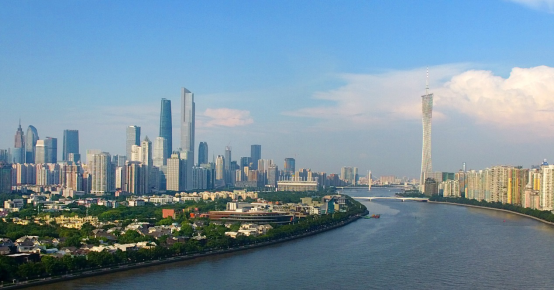
Guangzhou, referred to as Yangcheng, is the capital and political, economic, scientific technology, educational, and cultural center of Guangdong Province. It is a key city, international trade center, and transportation hub of China. It is one of the core engines that power the Guangdong-Hong Kong-Macao Greater Bay Area. Guangzhou covers a total area of 7,434.40 square kilometers, and as of the end of 2021, Guangzhou had a permanent population of 18.8106 million. The picture above shows the contemporary and picturesque skyline of Guangzhou.
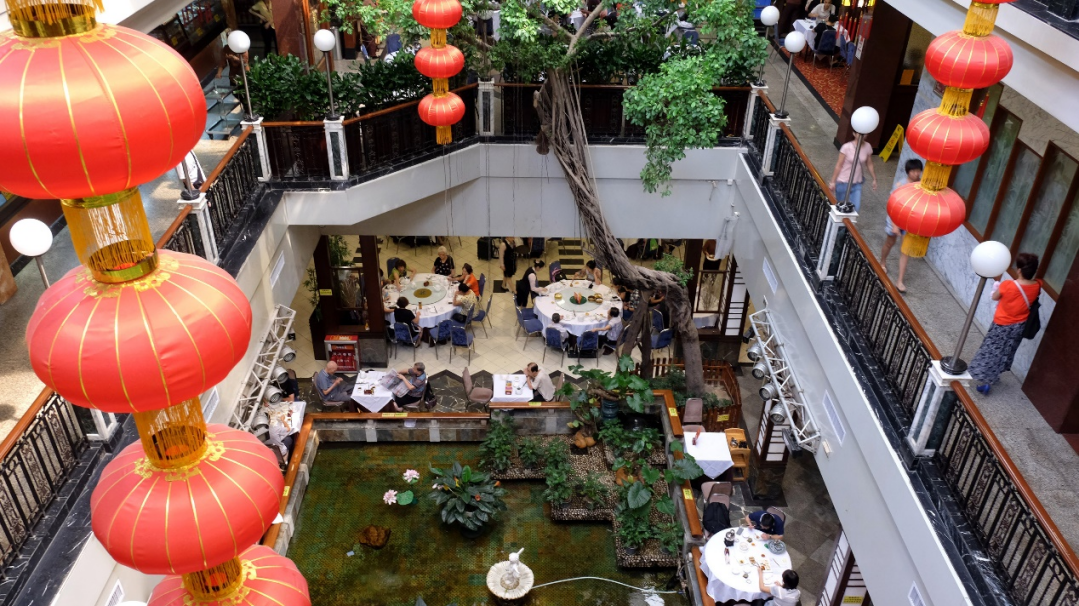
The Dim Sum culture has become the city business card of Guangzhou. In Guangzhou, walking into a teahouse and calling ”Dim Sum Depot" is an essential daily routine of the native Cantonese, and a long-standing custom of Lingnan. The picture shows an attractive teahouse scene in Guangzhou.

Guangzhou has been honored as the city of flowers for its warm and rainy climate, abundant light and heat, spring-like year-round seasons, and lush vegetation layers. The picture below shows tranquil Guangzhou Haizhu Wetland Park.
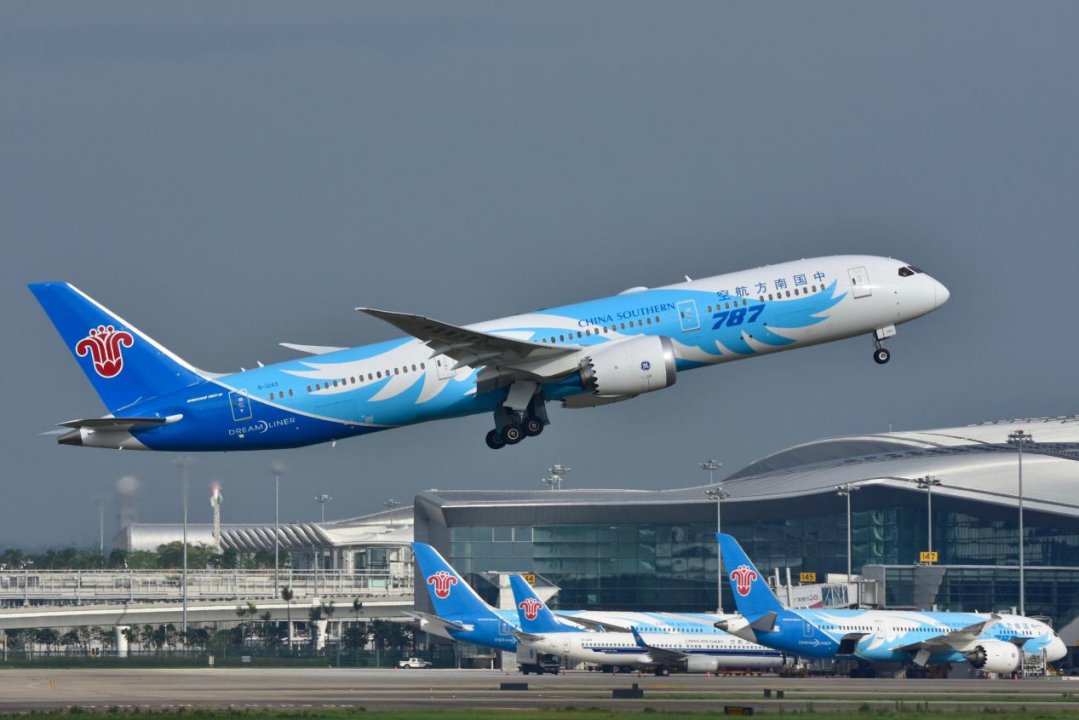
Guangzhou boasts the modern Guangzhou Baiyun International Airport, one of the three largest international aviation hubs and one of the national hub airports in China. In 2021, the number of travel services at Guangzhou Baiyun International Airport reached 40.231 million, ranking the first across the country. The picture below shows a Boeing 787 airliner taking off from Guangzhou Baiyun International Airport.
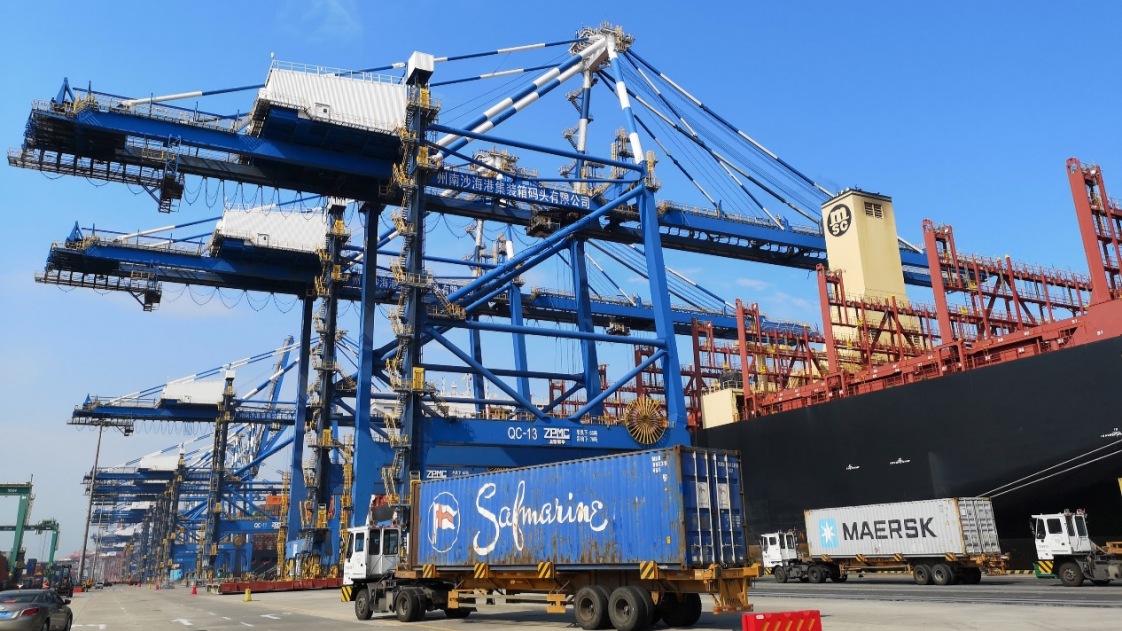
Guangzhou possesses a convenient and comprehensive transportation system, and has the first fully automatic wharf for river-sea-rail multimodal transport in the world. It is called the Fully Automatic Wharf Phase IV of the Nansha Port Area, Guangzhou Port. In recent years, the cargo and container throughput of Guangzhou Port have risen to the global ranks of fourth and fifth, respectively. Both the number of high-speed railway services and the passenger traffic of Guangzhou South Railway Station rank first in China. The picture below shows the energetic Guangzhou Port.
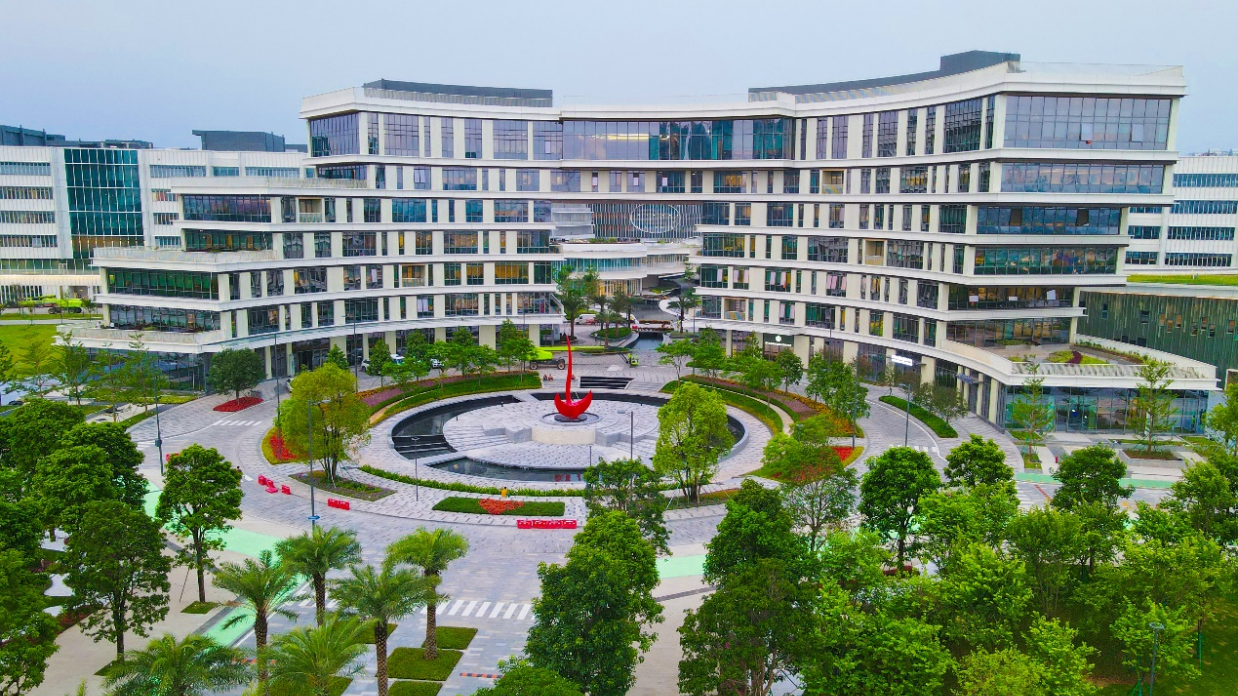
Presently, Guangzhou is making new achievements in comprehensive urban functions, comprehensive strength of urban culture, modern service industry, and modern international business environment. It is collaborating with Shenzhen to drive the further development of the province. In June, 2022, the State Council issued the Overall Plan of Nansha, Guangzhou for Deepening the All-round Cooperation between Guangdong, Hong Kong, and Macao Facing the World, which drew a new blueprint for the development of Guangzhou, especially Nansha. The picture below shows the fascinating Hong Kong University of Science and Technology (Guangzhou) in Nansha.
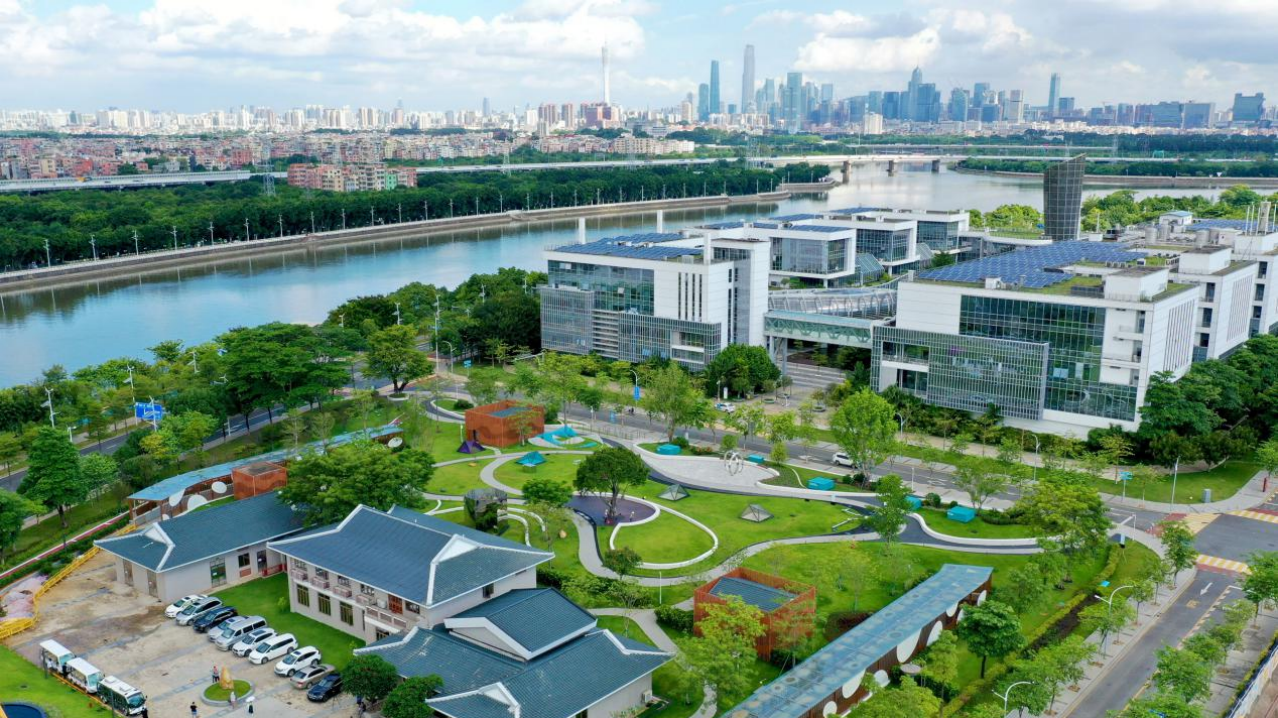
Guangzhou has continuously exhibited bursts of innovation vitality. Guangzhou Laboratory and the Greater Bay Area National Center of Technology Innovation have been successfully placed into operation. Human cell lineage research and cold spring ecosystem exploration have been included in the national special plan. R&D investment is expected to account for 3.15% of the GDP. The picture below shows Guangzhou International Bio Island, one of the key clusters of the bio-pharmaceutical industry in Guangzhou.
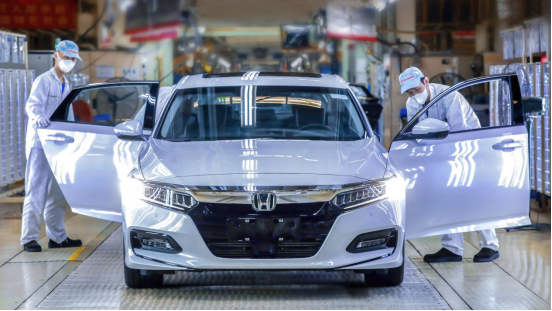
In 2021, 6 advanced manufacturing clusters, each having an output value exceeding 100 billion RMB, and 6 service industries, each having an added value exceeding 100 billion RMB, were established in Guangzhou. The added value of strategic emerging industries accounted for more than 30% of the regional GDP. The picture above shows a production line of the GAC Group.
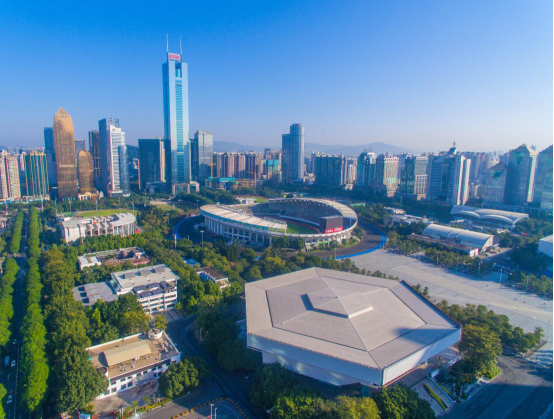
In 2021, the GDP of Guangzhou prefecture was 2.82 trillion RMB, an increase of 8.1% over the previous year and an average annual increase of 6.1% for the 5th consecutive year. The added value of the private economy, total retail sales of social consumer goods, and total import and export of commodities were more than 1 trillion RMB. The picture above shows a breathtaking view of the CITIC Plaza located in the new central axis of Guangzhou.

Guangzhou, referred to as Yangcheng, is the capital and political, economic, scientific technology, educational, and cultural center of Guangdong Province. It is a key city, international trade center, and transportation hub of China. It is one of the core engines that power the Guangdong-Hong Kong-Macao Greater Bay Area. Guangzhou covers a total area of 7,434.40 square kilometers, and as of the end of 2021, Guangzhou had a permanent population of 18.8106 million. The picture above shows the contemporary and picturesque skyline of Guangzhou.

The Dim Sum culture has become the city business card of Guangzhou. In Guangzhou, walking into a teahouse and calling ”Dim Sum Depot" is an essential daily routine of the native Cantonese, and a long-standing custom of Lingnan. The picture shows an attractive teahouse scene in Guangzhou.
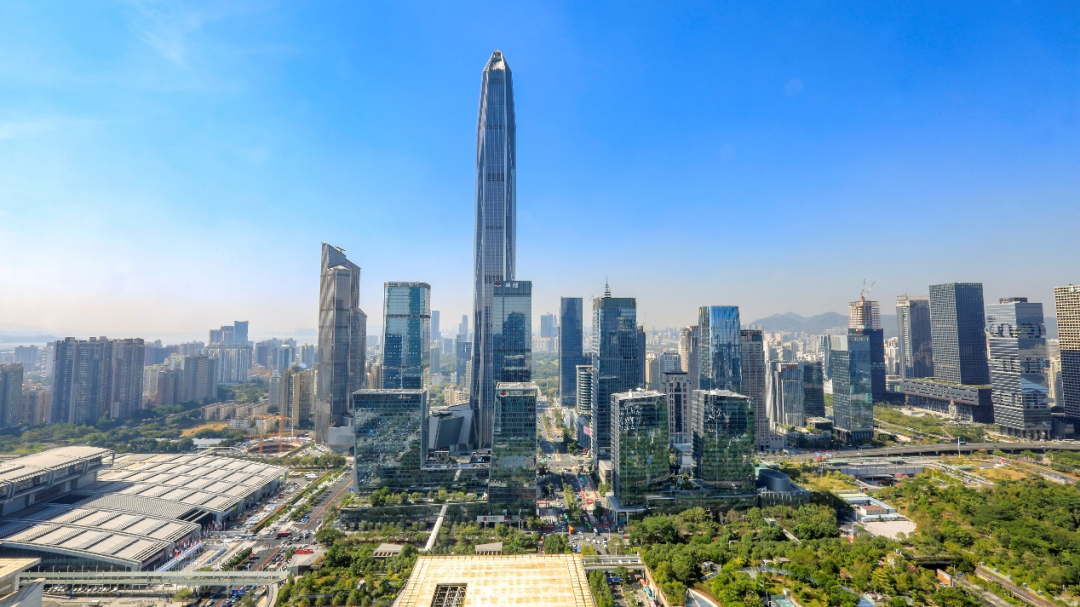
Shenzhen, also known as Pengcheng, is a coastal city in South China. It sits adjacent to Hong Kong, China in the south of Guangdong Province and on the east bank of the Pearl River Estuary. Shenzhen faces Daya Bay and Mirs Bay on the east, the Pearl River Estuary and Lingding Bay on the west, Shenzhen River and Hong Kong on the south, and Dongguan and Huizhou on the north. The city covers an area of 1,997.47 square kilometers. Its climate is mild and livable with plenty of rain and subtropical maritime monsoon weather. The picture below shows the scenery of Shenzhen.
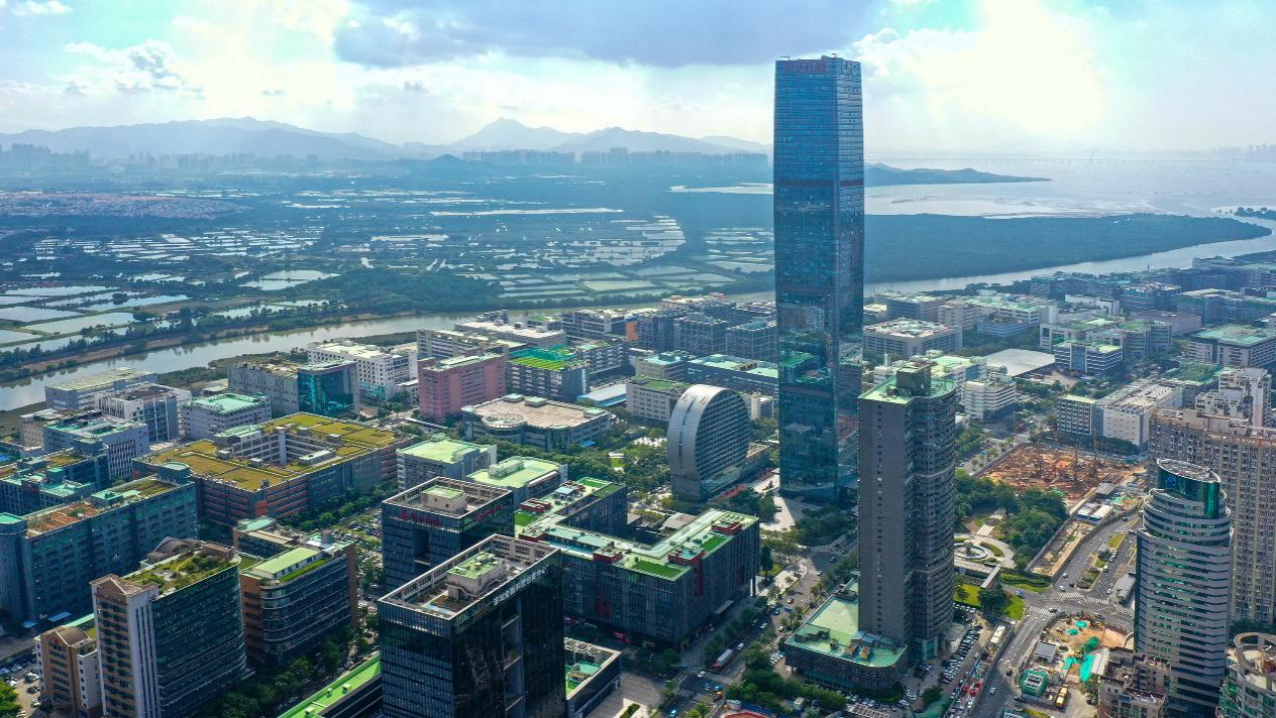
At the same time, relying on major strategic platforms, such as Qianhai and Hetao, Shenzhen has collaborated with Hong Kong in pragmatic cooperative projects in science/technology innovation, transportation infrastructure, finance, law, education, medical care, etc. These successful projects have enhanced the livelihoods and well-being of countless people in two places and helped Hong Kong to better integrate into the overall national development situation. The picture below shows the Hetao Shenzhen-Hong Kong Science and Technology Cooperation Zone.
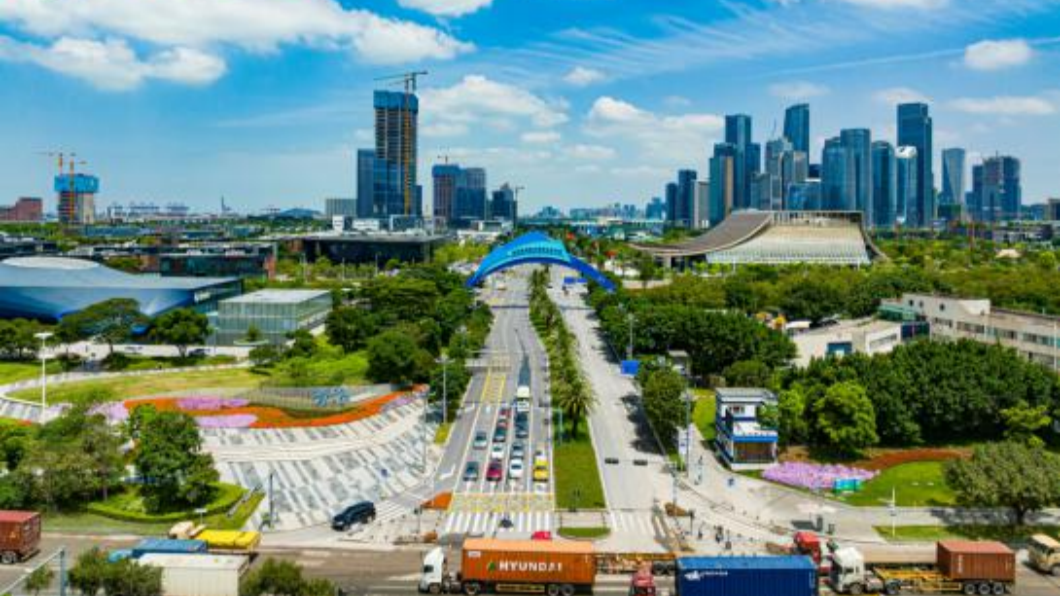
In 2021, the Central Committee of the Communist Party of China and the State Council issued the Plan of Comprehensively Deepening the Reform and Opening-up of Qianhai Shenzhen-Hong Kong Modern Service Industry Cooperation Zone. All departments in the city have achieved 75 innovations within Qianhai pilot system, for a total of 685 innovations. The picture below shows the Qianhai Shenzhen-Hong Kong Modern Service Industry Cooperation Zone.
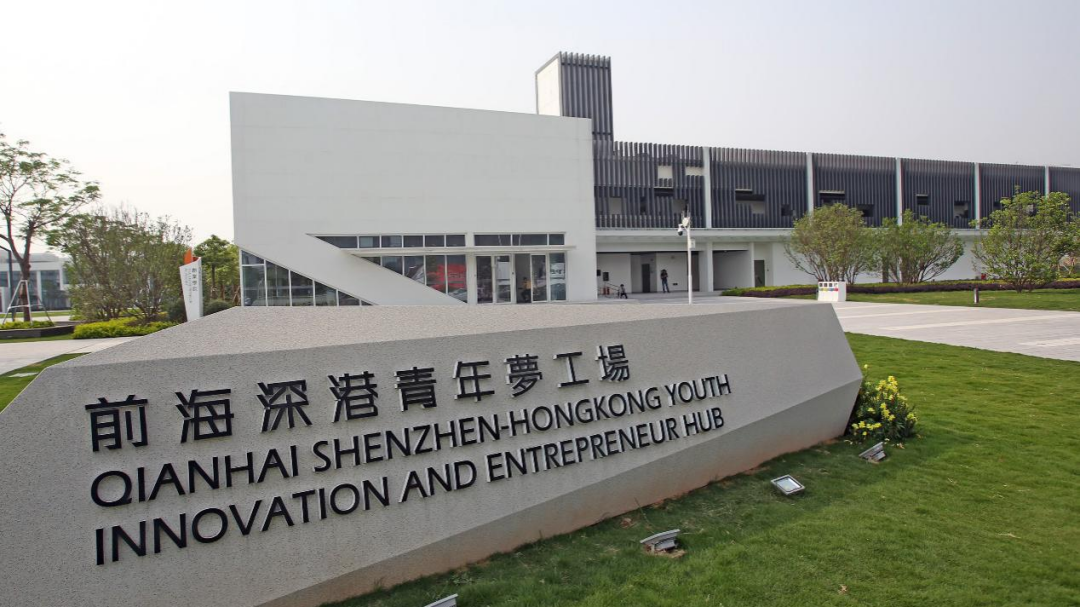
Shenzhen has become the global capital of entrepreneurs, with an entrepreneur among every 10 people. The full-time equivalent of R&D personnel reached 346,000 person-years, ranking first among cities in China. The picture below shows the Qianhai Shenzhen-Hong Kong Youth Innovation and Entrepreneur Hub.
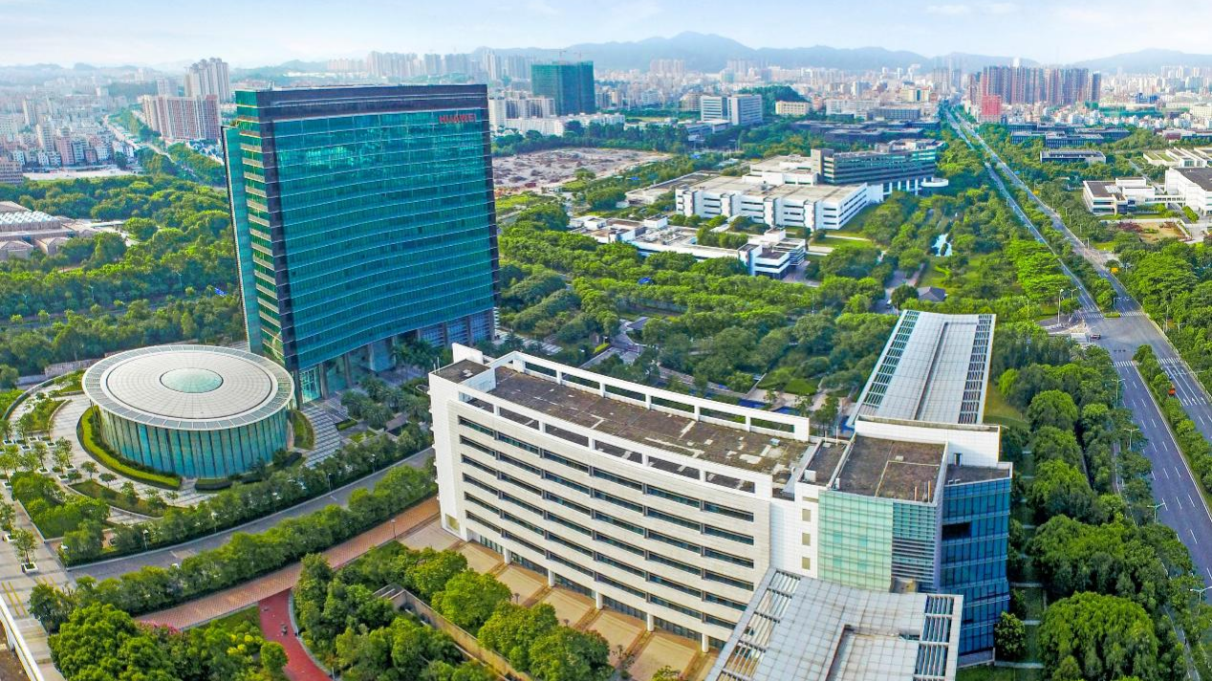
Shenzhen is committed to building a complete-process innovation ecological chain of basic research + technological breakthrough + industrialization of achievements + sci-tech finance + talent support. It will form a technological innovation system with businesses as the main body, market as the orientation, and an in-depth collabration of industry-university-research. Thus, a large number of innovative companies, represented by Huawei, BYD, Tencent, and DJI, have emerged. The picture below shows a high-tech business located in Bantian, Shenzhen.
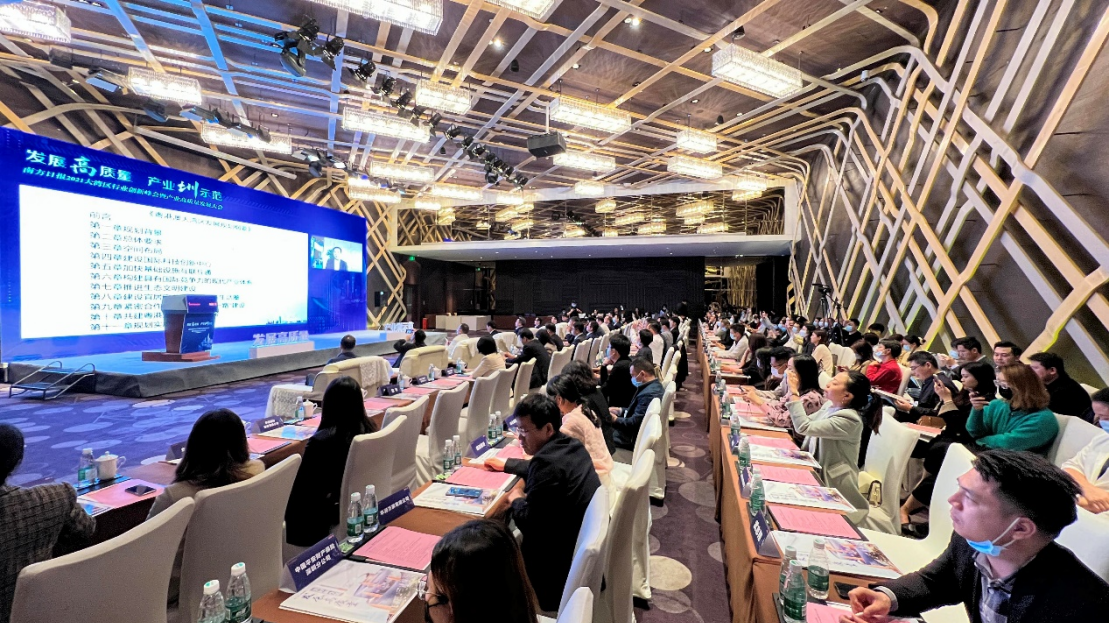
Innovation is a gene of Shenzhen. Shenzhen is the first city in China to be listed independently as national innovation demonstration area. It has been rated as one of the best cities for innovation and entrepreneurship in China. According to the 2021 statistics, Shenzhen’s R&D budget accounted for 5.46% of its GDP. Shenzhen had 21,000 national high-tech businesses, ranking second in China. The picture below shows the Industrial Innovation Summit of the Greater Bay Area in 2021.
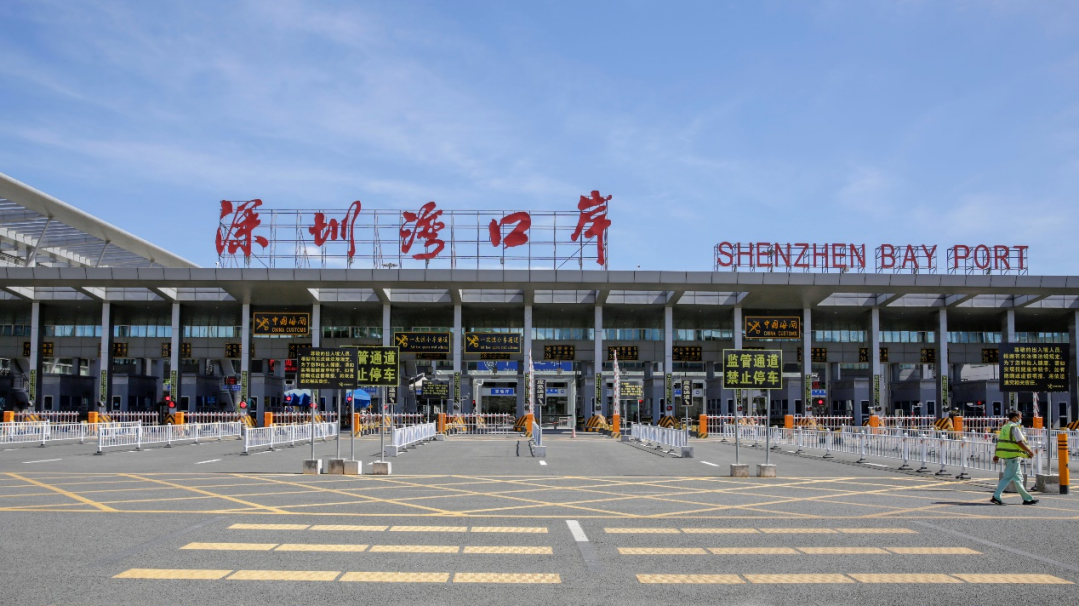
In 2021, the total import and export volume of Shenzhen was 3.5 trillion RMB, an increase from the prior year of 16.2%. Among them, the total export volume increased by 13.5%, ranking first among mainland cities for the 29th consecutive year. The actually utilized foreign capital was 10.97 billion USD, an increase of 26.3%. The picture below shows Shenzhen Bay Port.
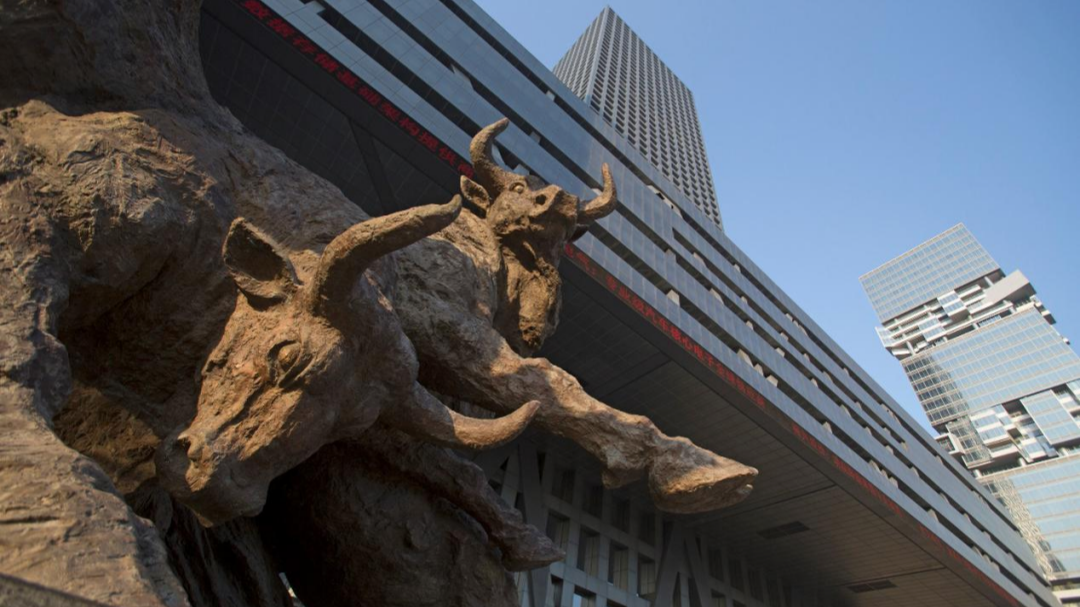
In 2021, the total economic output of Shenzhen exceeded 3 trillion RMB, ranking the fourth among Asian cities. The local general public budget revenue of the city was 425.8 billion RMB, and the gross output value of industrial businesses above the designated size ranked first among cities in China for the third consecutive year. The export scale of Shenzhen impressively ranked first among mainland cities for the 29th consecutive year. The picture below shows the new site of the Shenzhen Stock Exchange.

Shenzhen, also known as Pengcheng, is a coastal city in South China. It sits adjacent to Hong Kong, China in the south of Guangdong Province and on the east bank of the Pearl River Estuary. Shenzhen faces Daya Bay and Mirs Bay on the east, the Pearl River Estuary and Lingding Bay on the west, Shenzhen River and Hong Kong on the south, and Dongguan and Huizhou on the north. The city covers an area of 1,997.47 square kilometers. Its climate is mild and livable with plenty of rain and subtropical maritime monsoon weather. The picture below shows the scenery of Shenzhen.

At the same time, relying on major strategic platforms, such as Qianhai and Hetao, Shenzhen has collaborated with Hong Kong in pragmatic cooperative projects in science/technology innovation, transportation infrastructure, finance, law, education, medical care, etc. These successful projects have enhanced the livelihoods and well-being of countless people in two places and helped Hong Kong to better integrate into the overall national development situation. The picture below shows the Hetao Shenzhen-Hong Kong Science and Technology Cooperation Zone.
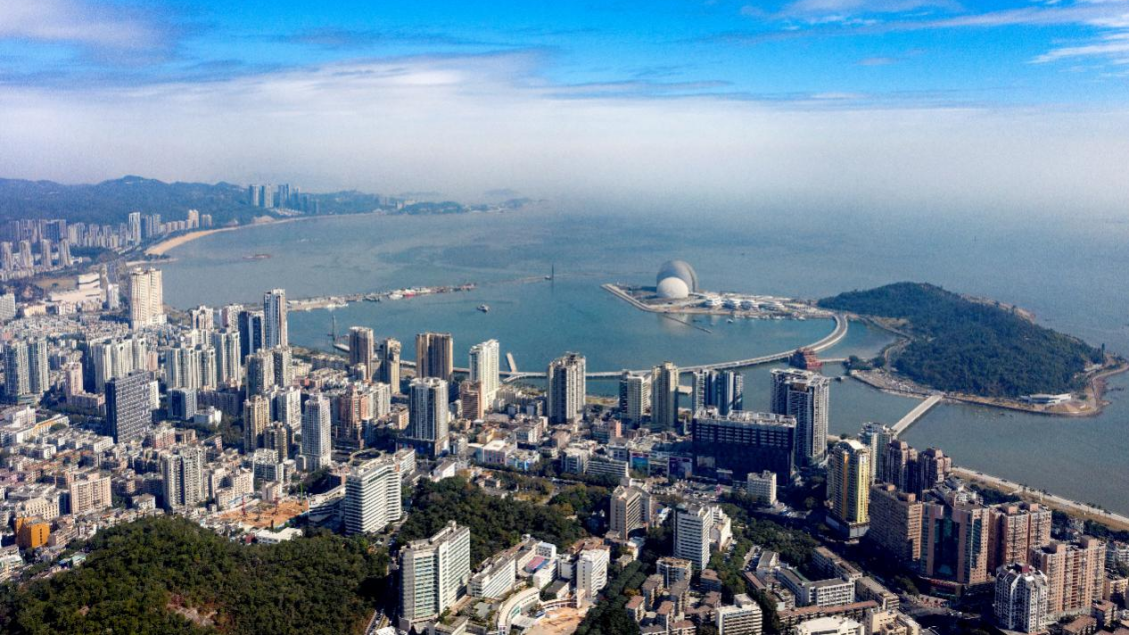
Zhuhai enjoys a superior location. It borders the South China Sea, is 36 sea miles from the Hong Kong waterway to the east, and connecting Macao on the south. Zhuhai is a key node city in the Guangdong-Hong Kong-Macao Greater Bay Area. The picture below shows the urban area of Zhuhai.
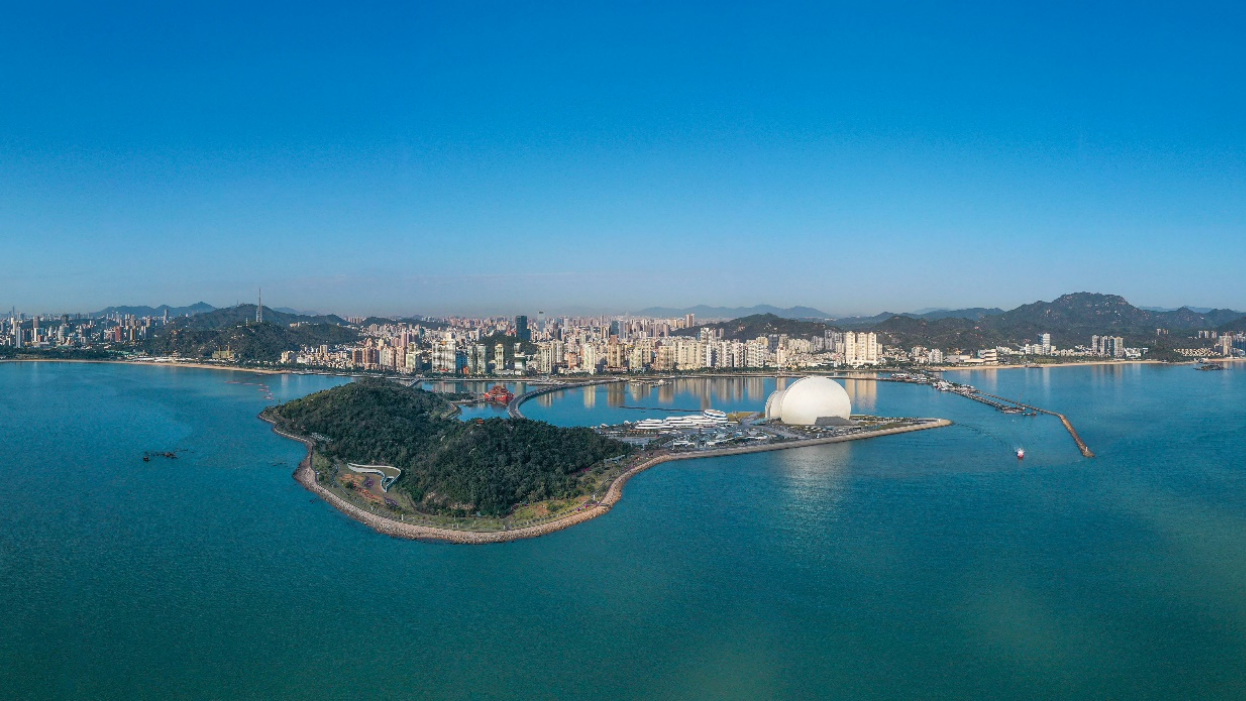
Zhuhai is the only city in China that has been selected as one of the Top 40 National Tourist Attractions for its overall urban landscape and first-class living environment. The picture below shows the beautiful scenery of Zhuhai.
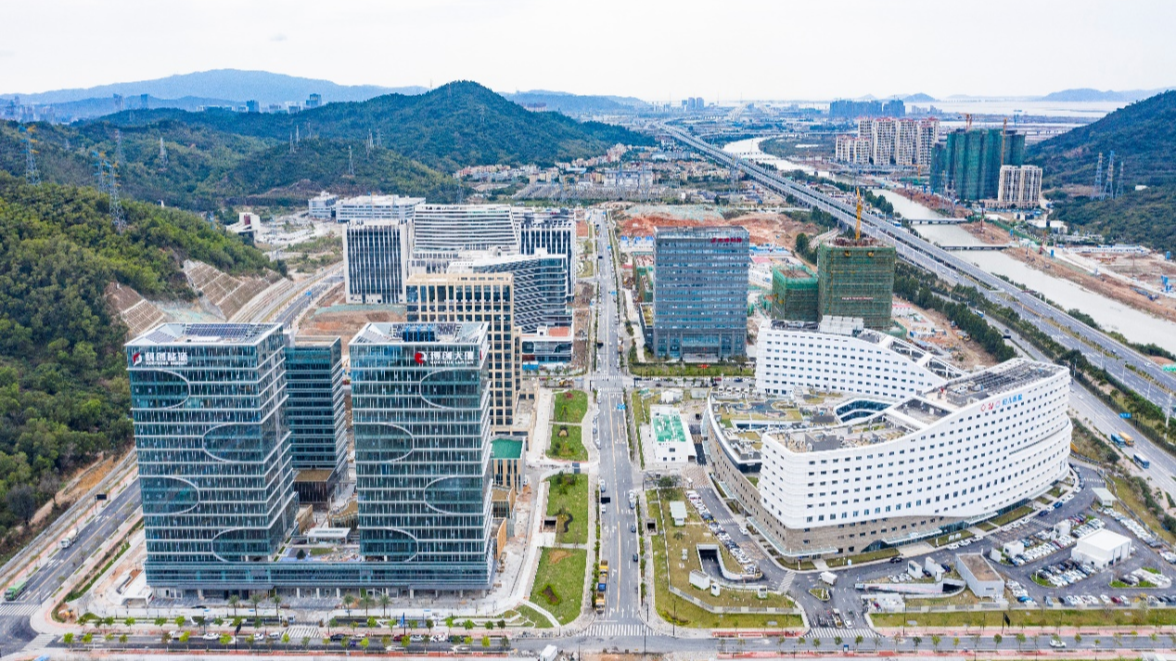
In recent years, Zhuhai has thoroughly implemented an innovation-driven development strategy, and high-quality development has added new kinetic energy. There are more than 2,100 high-tech businesses in the city, contributing a number of innovative achievements, such as AG600, the largest amphibious aircraft in the world. Nine projects have won the National Science and Technology Progress Award. The picture below shows Nanping Science-technology Industrial Park.
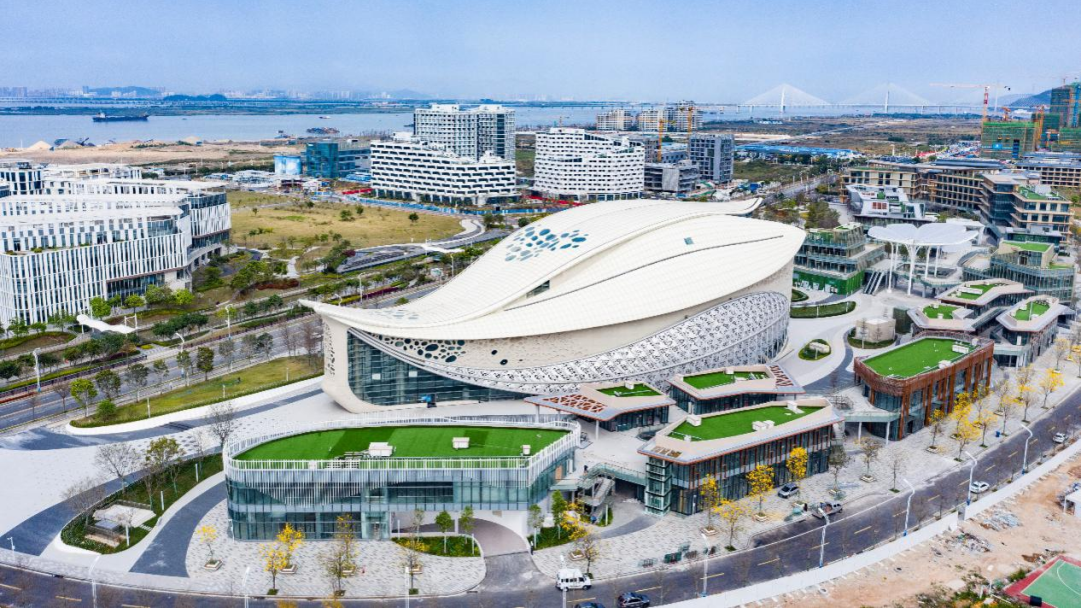
Zhuhai actively promotes Zhuhai-Macao cooperation. The agglomerative effects of platforms, such as the Guangdong-Macao Cooperative Industrial Park, Traditional Chinese Medicine Science and Technology Industrial Park of Cooperation between Guangdong and Macao, and Guangdong-Macao In-depth Cooperation Zone in Hengqin, continue to emerge. The picture below shows the Traditional Chinese Medicine Science and Technology Industrial Park of Cooperation between Guangdong and Macao.
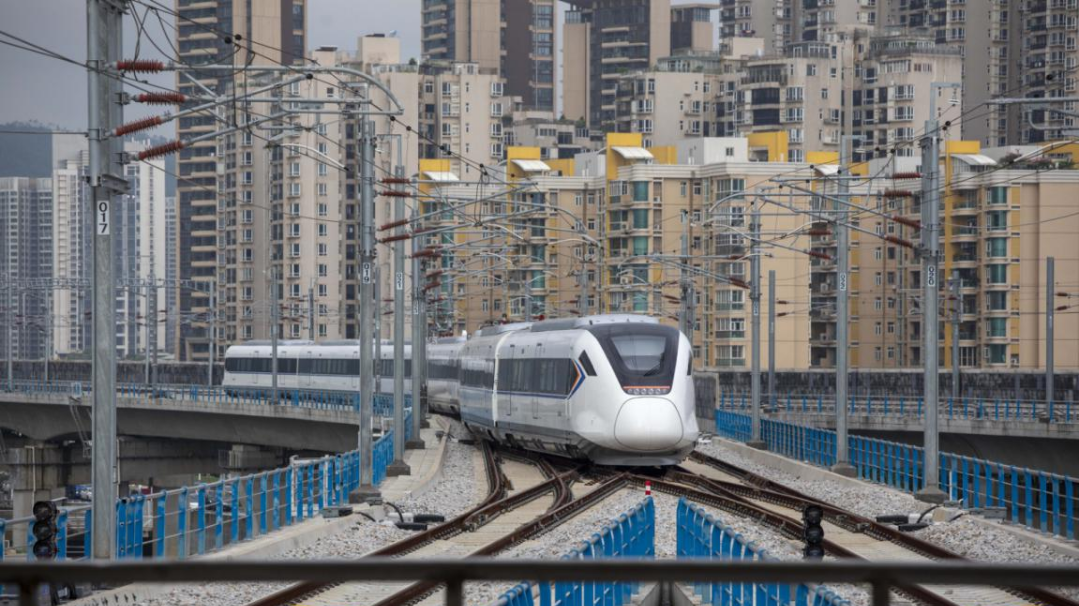
The transportation network of Zhuhai is constantly improving. Gongbei Port is connected with Macao land, and it takes only an hour to get from Jiuzhou Port to Shenzhen or Hong Kong. The Guangzhou-Zhuhai Intercity Railway connects Guangzhou, Foshan, Zhongshan, and Zhuhai in series, and it takes only 41 minutes to reach Zhuhai from Guangzhou. Since the completion of the Hong Kong-Zhuhai-Macao Bridge, Zhuhai has become the only Chinese mainland city simultaneously connected with Hong Kong and Macao by land. The picture below shows a train setting out from Zhuhai Station.
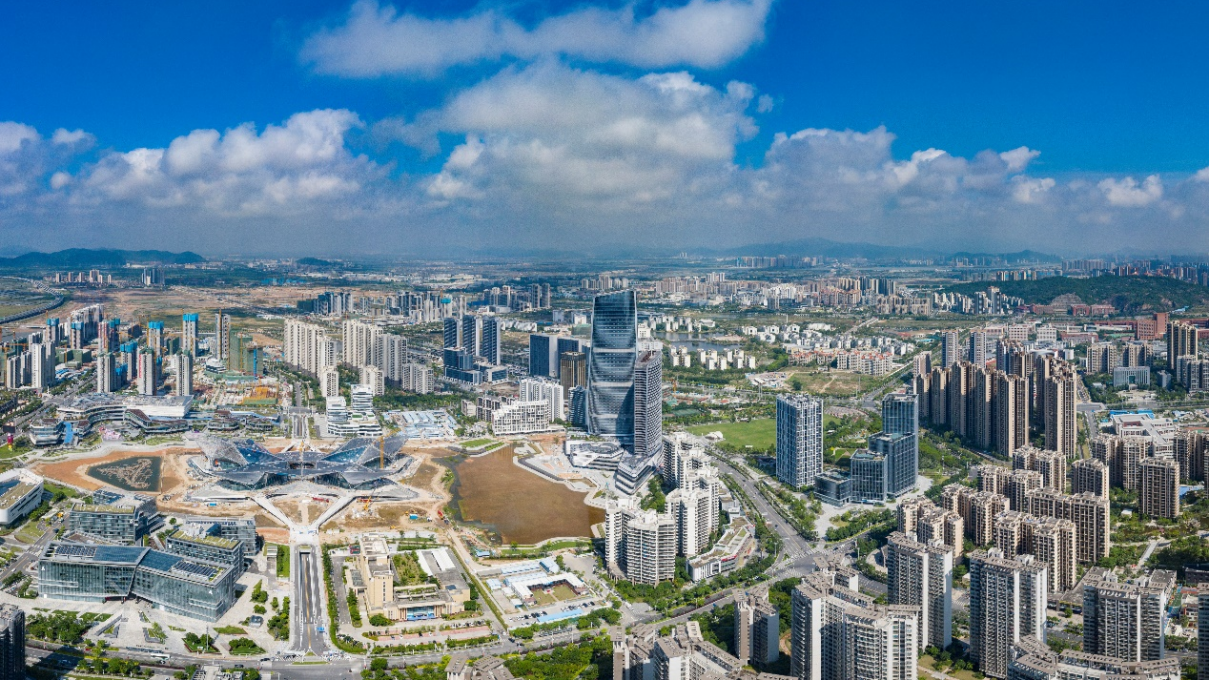
In 2021, Zhuhai achieved a regional GDP of RMB 388.175 billion, an increase of 6.9% from the previous year. Zhuhai also accomplished a per capita GDP of 157,900 RMB, an increase from the prior year of 4.0%. The city attained an added value of above-scale industries of 133.937 billion RMB, an increase from the previous year of 8.8%. The total retail sales of social consumer goods reached 104.824 billion RMB, a year-on-year increase of 13.8%. The total import and export volume of 332.008 billion RMB was an increase from the previous year of 21.5%. The picture below shows Golden Bay Aviation City.
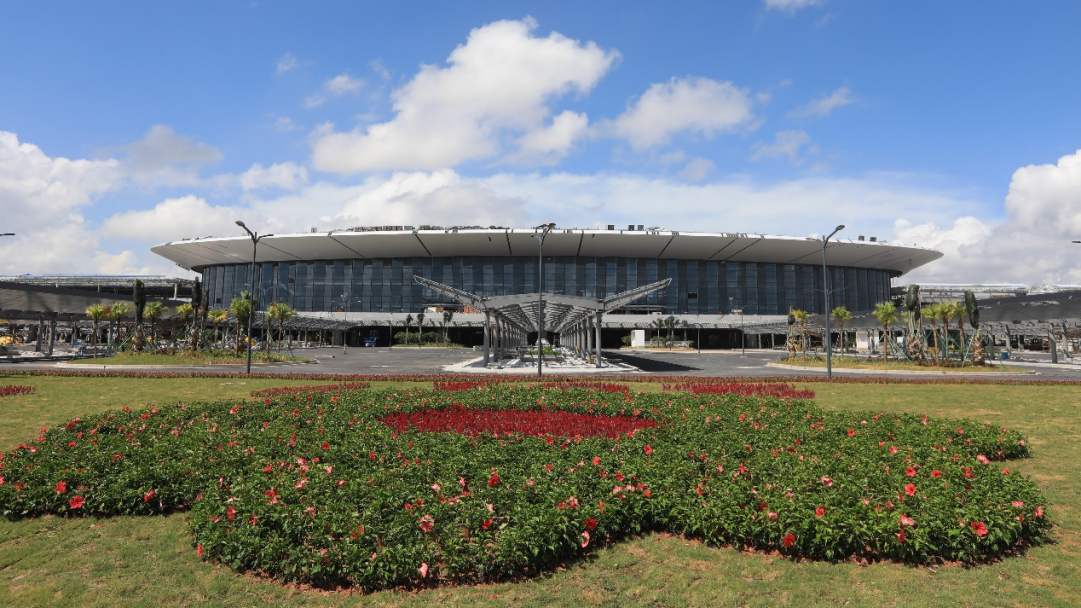
Zhuhai is another important port city in China. It is home to a total of 10 national first-class ports: five land ports - Gongbei, Hengqin, Qingmao, Zhuhai Highway of Hong Kong-Zhuhai-Macao Bridge, and Zhuhai-Macao Cross-border Industrial Zone. It has five water ports - Jiuzhou Port, Wanchai Ferry Pier, Zhuhai Port, Doumen Port, and Wanshan Port. It is the second largest port city in China after Shenzhen. The picture below shows the East Square of Zone A, Zhuhai Port Travel Inspection.
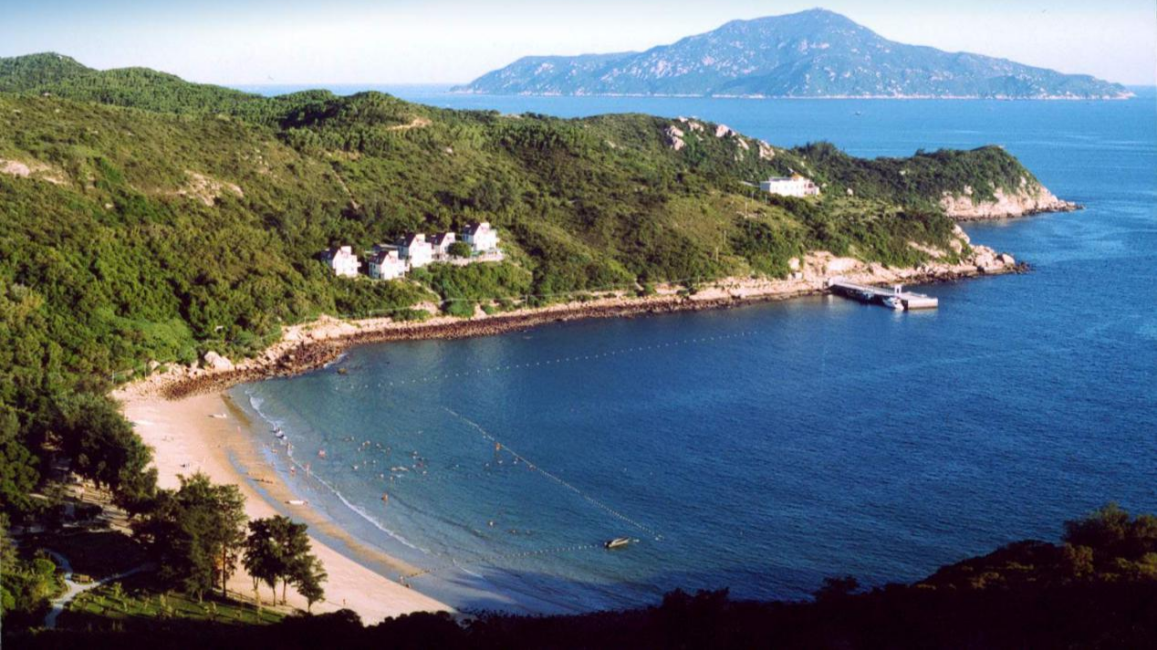
Zhuhai City boasts abundant marine resources, a vast sea area, and numerous islands. The sea area, within the territorial sea line of the city, is 9,348 square kilometers, and the mainland coastline is 224.5 kilometers. It has 262 islands, including 10 residential islands and 252 uninhabited islands. Zhuhai City has the largest sea area among the cities of the Pearl River Delta. The picture below shows an island in Zhuhai.

Zhuhai enjoys a superior location. It borders the South China Sea, is 36 sea miles from the Hong Kong waterway to the east, and connecting Macao on the south. Zhuhai is a key node city in the Guangdong-Hong Kong-Macao Greater Bay Area. The picture below shows the urban area of Zhuhai.

Zhuhai is the only city in China that has been selected as one of the Top 40 National Tourist Attractions for its overall urban landscape and first-class living environment. The picture below shows the beautiful scenery of Zhuhai.
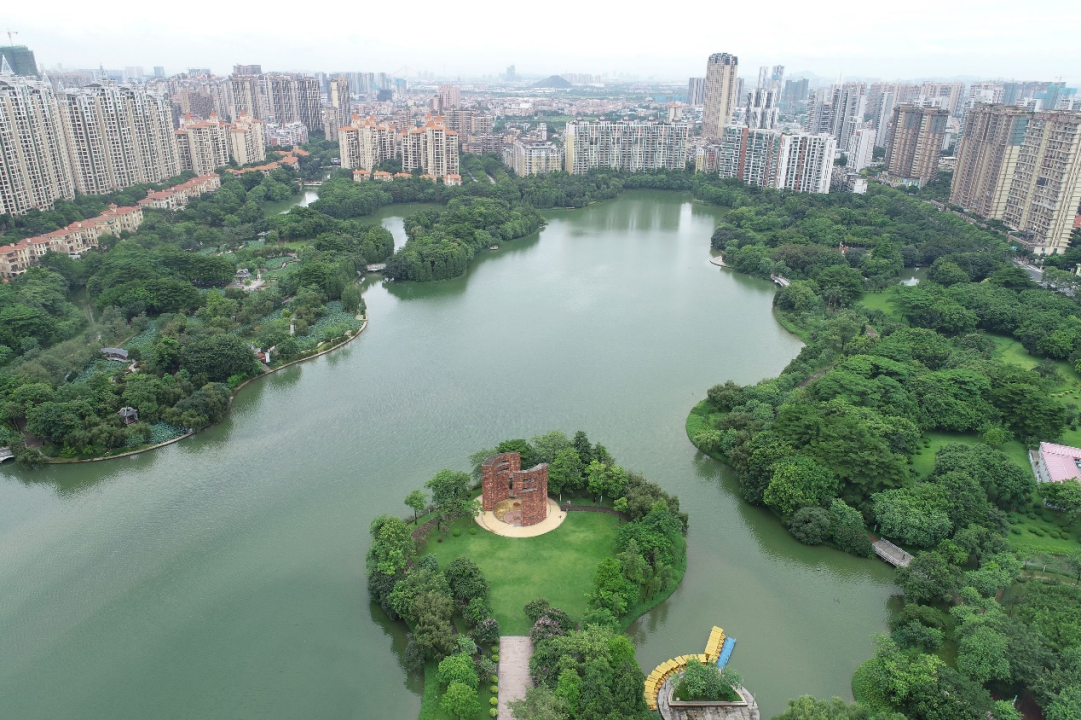
Foshan continues to show the strength of management on urban planning and construction. The city strenuously promotes the optimization of urban and rural spaces and shape remodeling. It provides citizens with high-quality ecological spaces for manufacturing and living. The picture below shows a city park in Gaoming, Foshan.

Foshan, a national city of innovation, has invested a total of more than 40 billion RMB in science and technology in the past five years. It has built a collaborative innovation system of talent introduction and education + technology R&D + achievement transformation + industrial application to accelerate the gathering of global innovation resources. As a result, it has become a significant force for the Guangdong-Hong Kong-Macao Greater Bay Area to build an international science and technology innovation center. The picture below shows the high-end innovation cluster of Sanlongwan, Foshan.
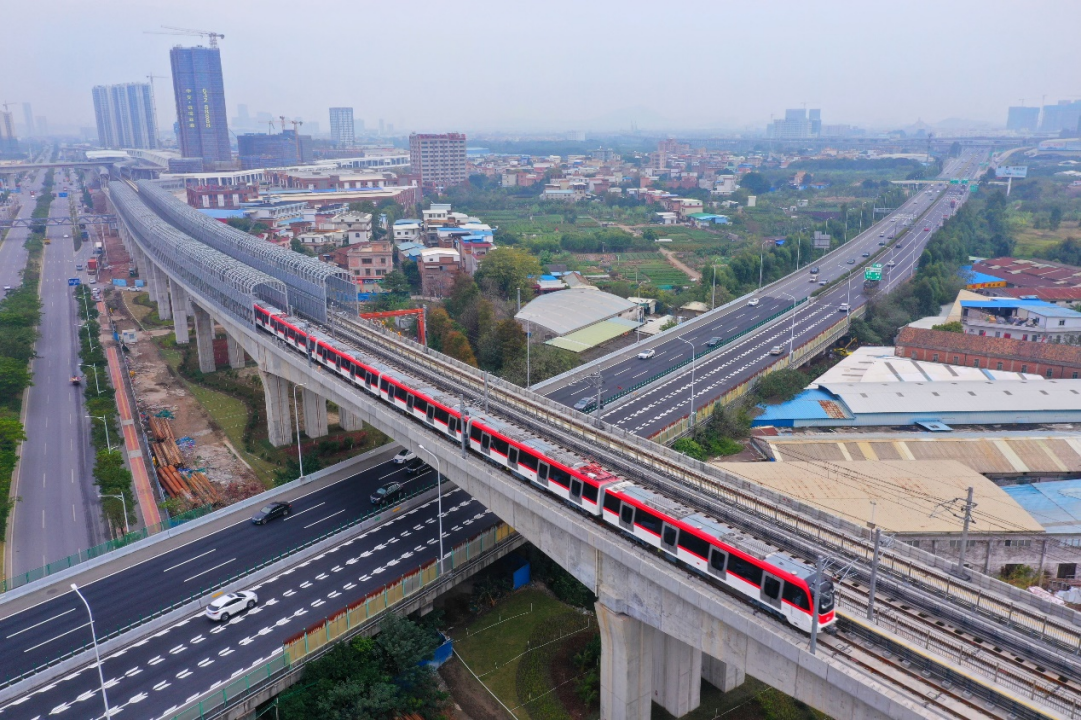
Foshan vigorously promotes the connectivity of infrastructure and institutional rules. It has deepened its connections and cooperation with Guangzhou, Shenzhen, Hong Kong, and Macao. Foshan promotes the coordinated development of both sides of the Pearl River Estuary and strengthens the radiative and leading roles in western and southwestern Guangdong. The picture below shows Metro Line 2 of Foshan.
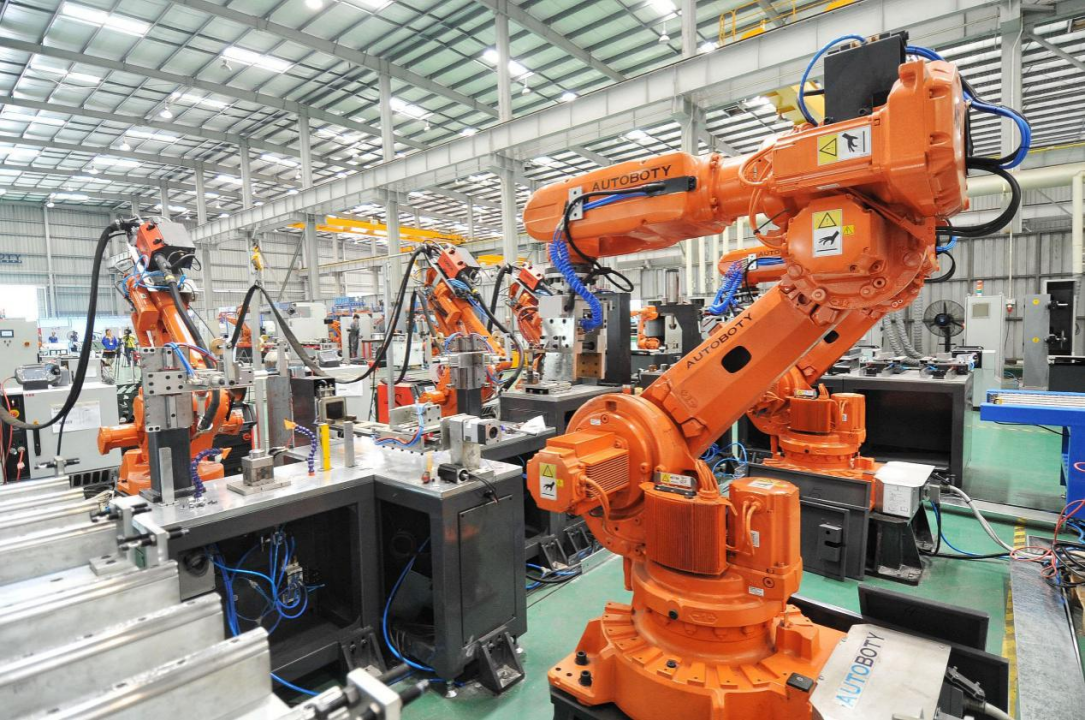
Foshan has gradually established a modern industrial system with complete categories and support facilities. Its industrial scale ranks sixth in China, and it is the only comprehensive reform pilot for the transformation and upgrade of the manufacturing industry in China. It is also a city where industry contributes nearly 60% of the GDP, which is rare among trillion-scale cities. Its products are exported to more than 100 countries and regions around the world. In 2021, the regional GDP of Foshan reached RMB 1,215.654 billion, with an average annual growth rate of 8.3%. The picture below shows a manufacturing workshop in Foshan.
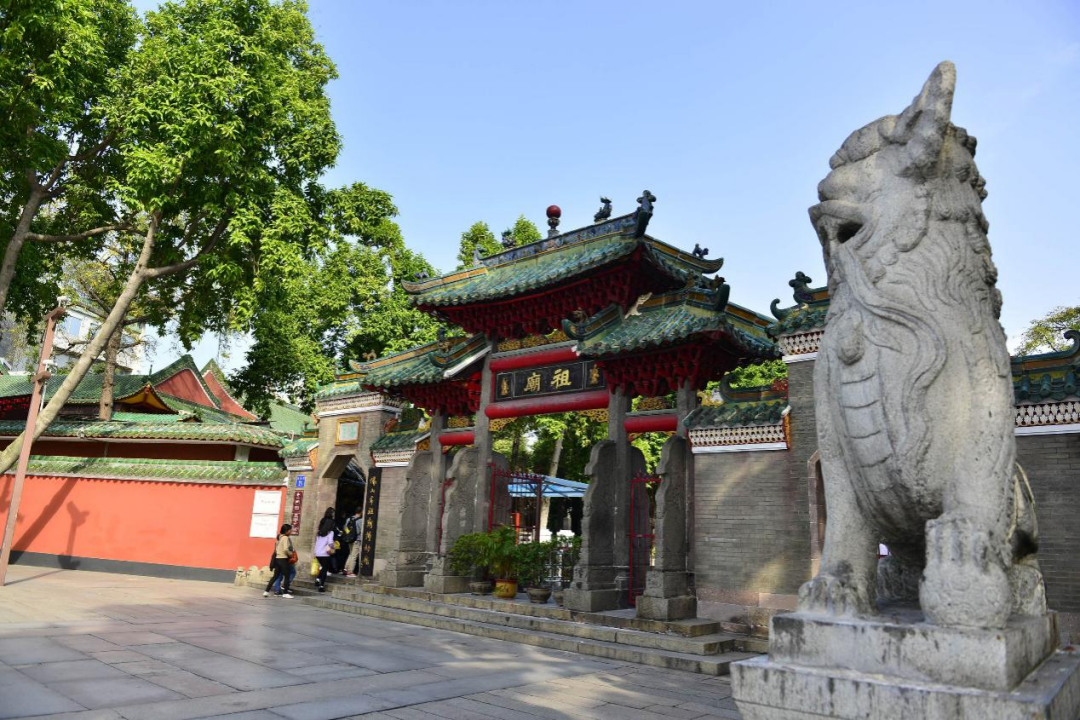
The traditional cultures of Foshan, such as Cantonese cuisine, martial arts, and ceramics, are widely renowned. They enlighten the world to these profound treasures and unique charms of this ancient city with a history of more than a thousand years. The picture below shows the Ancestral Temple, the center of Foshan beliefs.
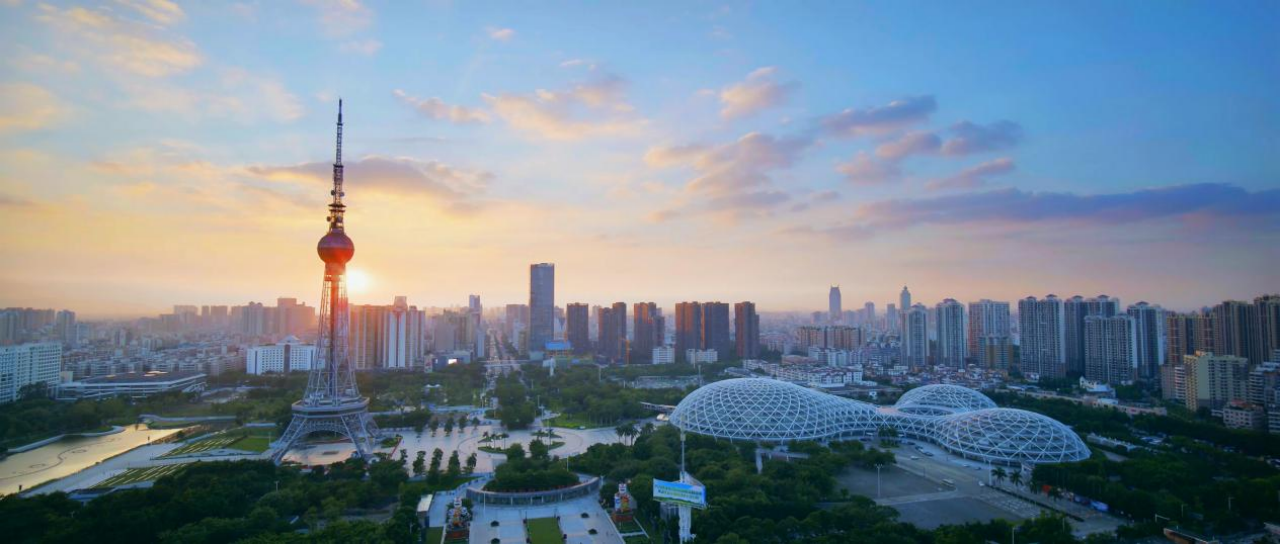
Foshan is located in the hinterland of the Pearl River Delta. It has Guangzhou on the east, and is close to Shenzhen, Hong Kong, and Macao. It is another key city in the Guangdong-Hong Kong-Macao Greater Bay Area, and it forms the Guangzhou-Foshan Metropolitan Area together with Guangzhou. The picture below shows the urban center of Foshan.
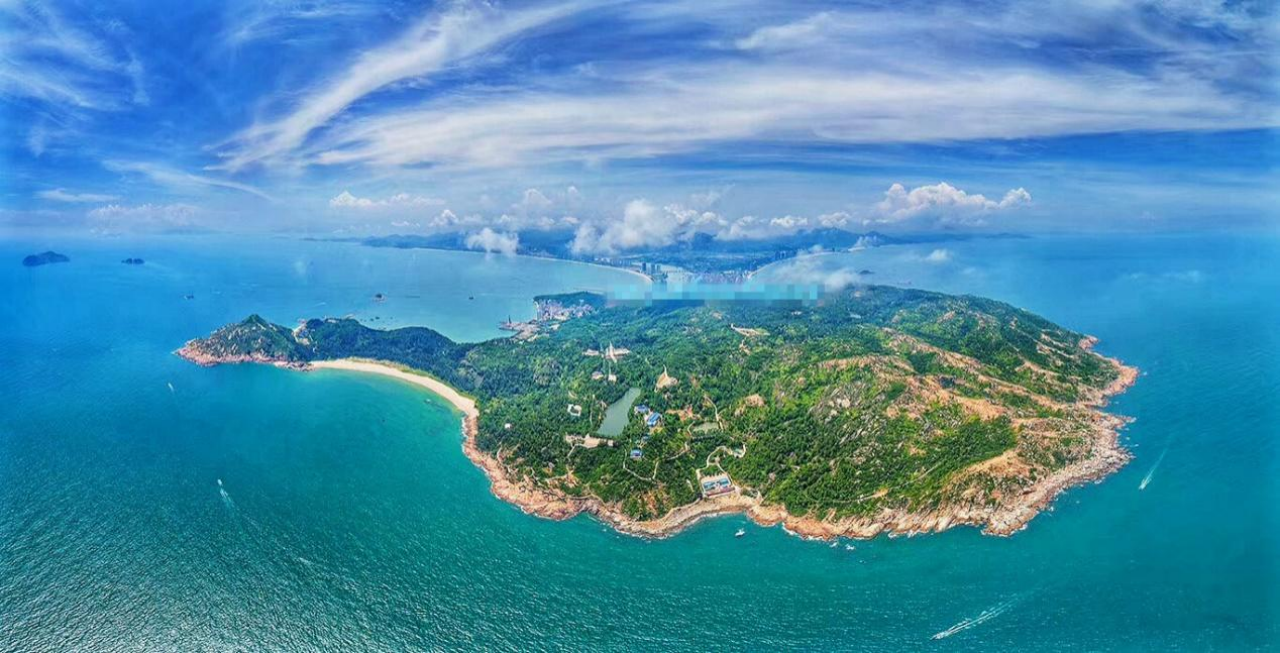
Huizhou has always given priority to ecology and constantly transformed ecological advantages into development advantages. The picture below shows the Huidong Turtle National Nature Reserve of Guangdong.
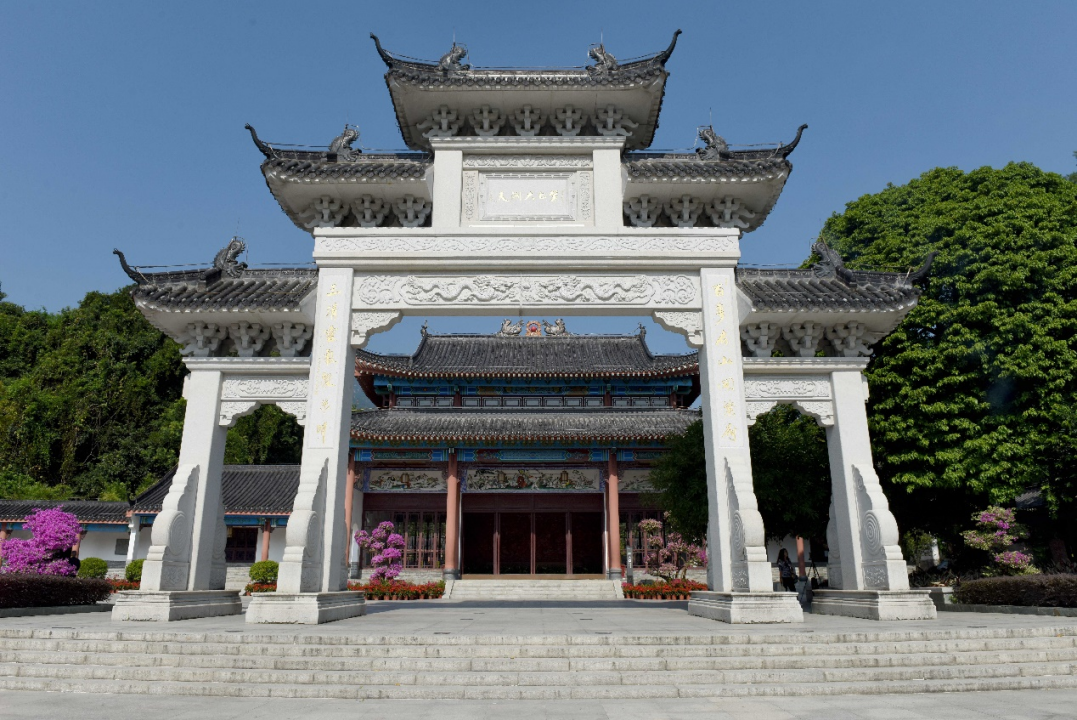
The confluence of the Dongjiang River and Xizhijiang River is here. By respecting nature and protecting ecology, Huizhou has created a uniquely livable environment. Huizhou has a beautiful ecological environment surrounded by mountains, lakes, rivers, and seas. The picture below shows Luofu Mountain.
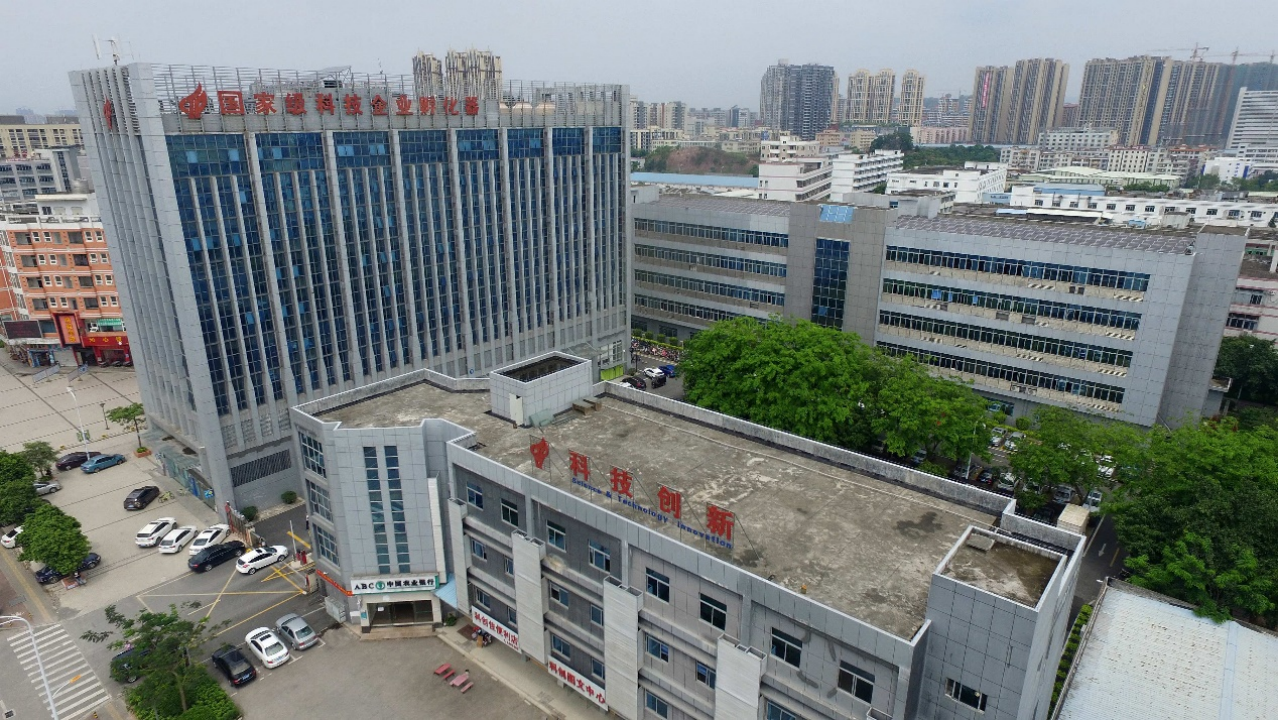
Huizhou has planned and built eight industrial parks above the provincial level, accelerated the planning and construction of the major development platform of Tonghu Ecological Smart Zone, and settled the Two Major Scientific Apparatus projects of the Chinese Academy of Sciences in Huizhou. The picture below shows the National Incubator of the Zhongkai High-tech Zone.
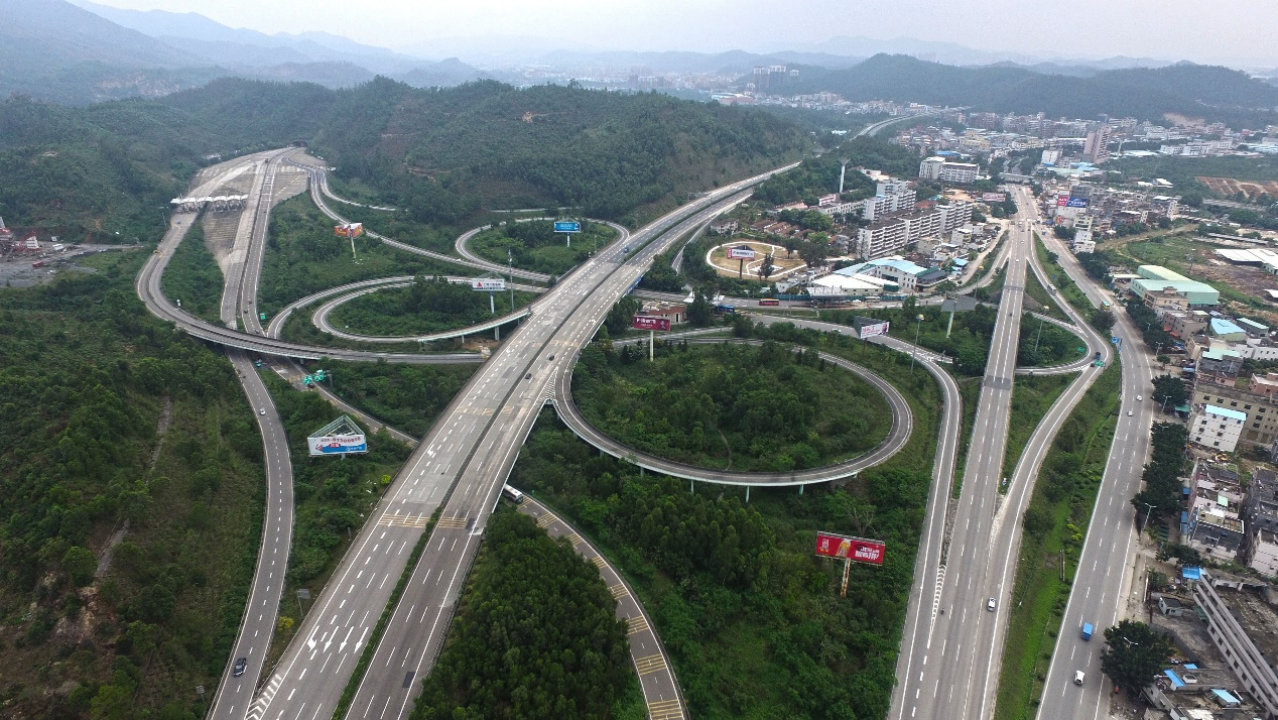
In recent years, Huizhou has eagerly developed traffic construction. A road network system of two ring roads and ten radial roads has been built in the Huicheng Central Area. This project has accomplished a connection between the Huicheng Central Area and the high-speed entrance that takes only 15 minutes. The picture below shows the Huizhou Zhongkai Interchange.
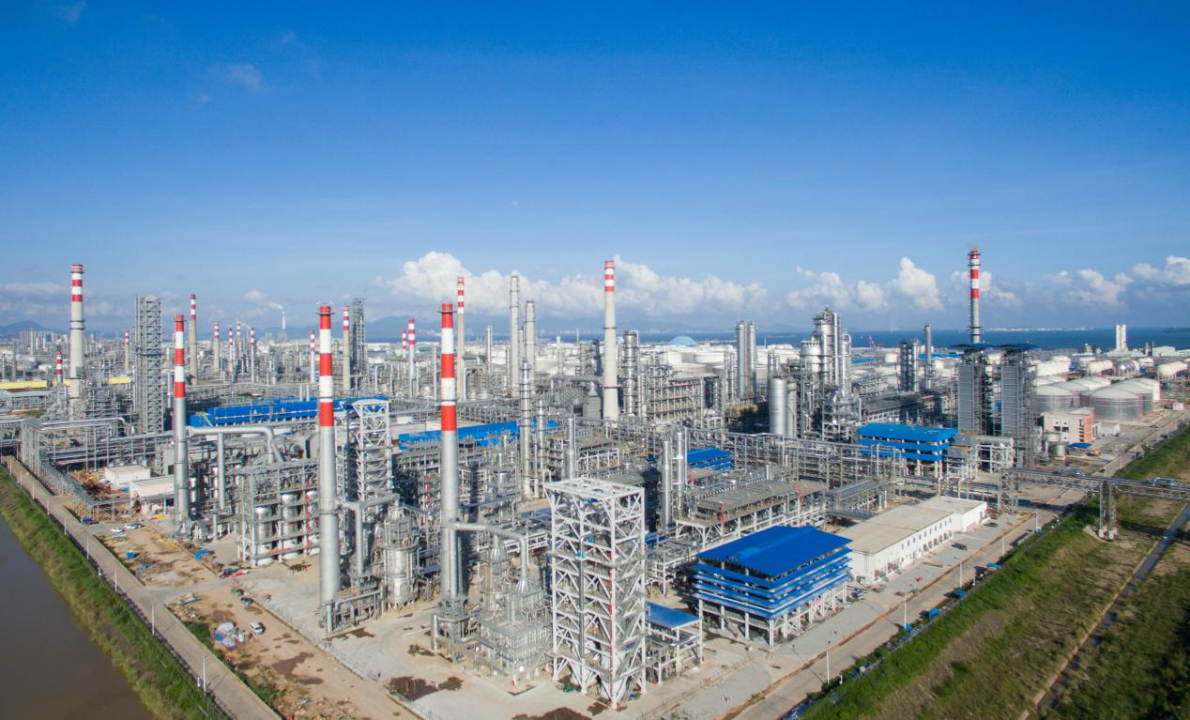
In 2021, the GDP of Huizhou reached 497.736 billion RMB, an increase from the prior year of 10.1%. At present, Huizhou is building a 2+1 modern industrial cluster, speeding up the construction of a world-class green petrochemical industry highland, constructing an interconnected world-class digital industrial base, and cultivating healthcare industries. Among them, the green petrochemical industry of Huizhou has made remarkable achievements, and the scale of refining and chemical integration in the Daya Bay Petrochemical Zone ranks first in China. The picture below shows the Daya Bay Petrochemical Zone.
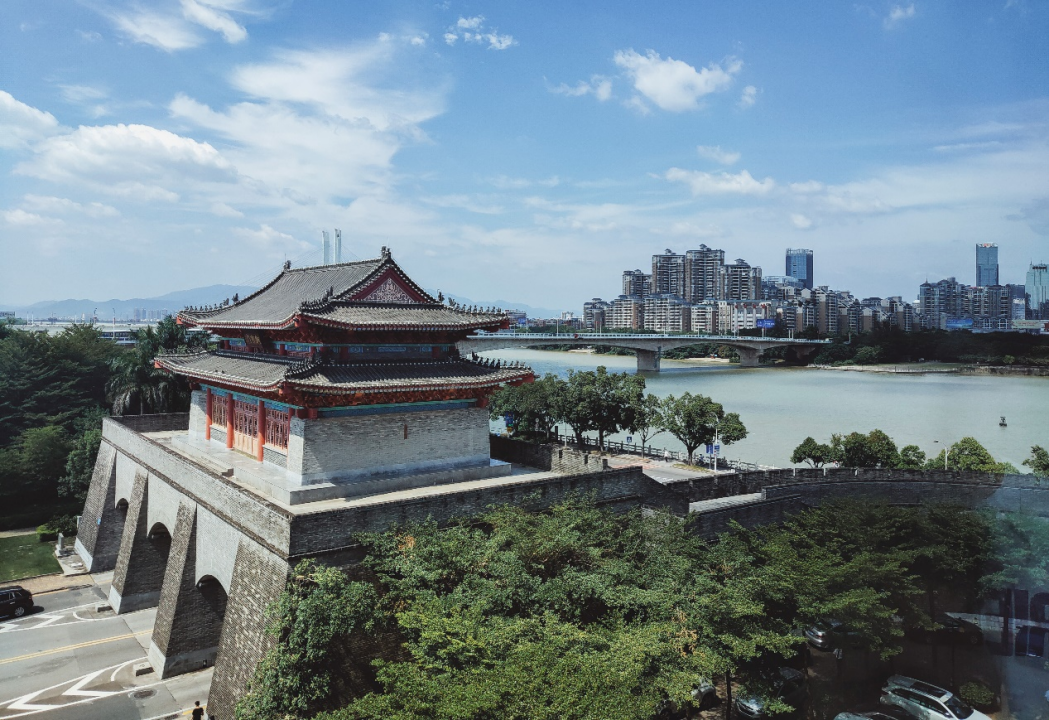
In Huizhou, Hakka culture, Guangfu culture, and Chaoshan culture are diverse and eclectic. Cultural activities, such as the Guangdong Han Opera, fishing songs, folk songs, and dragon and lion dances, are prevalent. Folk cultures are colorful in Huizhou. The picture below shows Chaojing Gate in Huizhou.
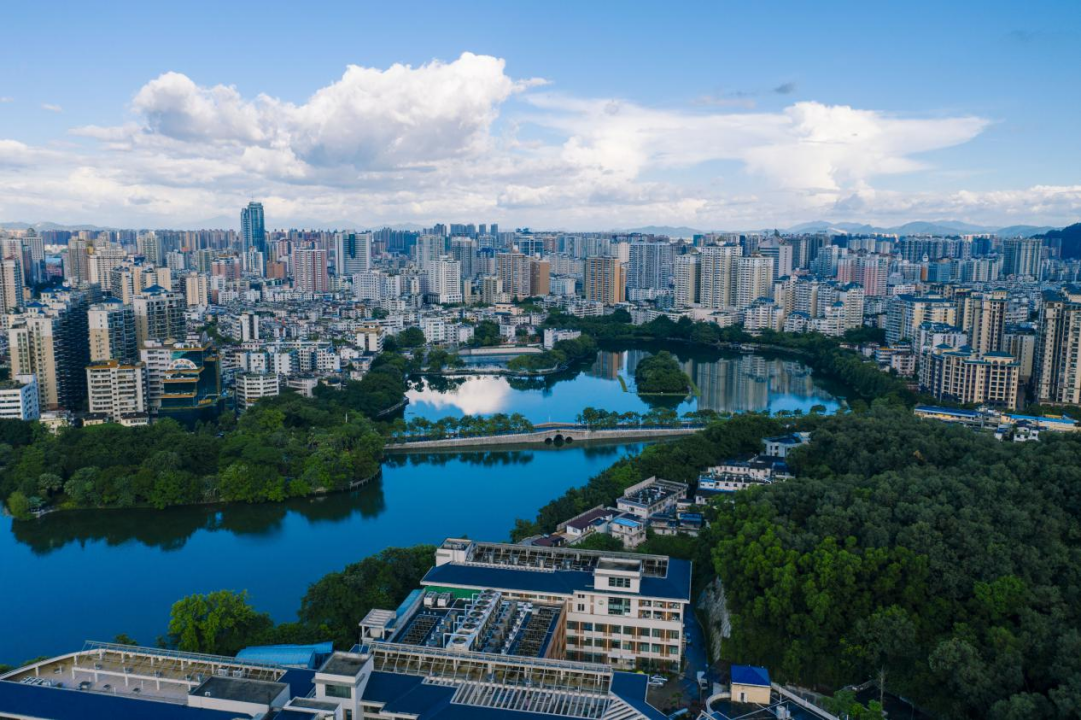
Huizhou is located in the southeast of Guangdong Province. It borders Shanwei to the east, connects Nanhai and Shenzhen to the south, is next to Dongguan to the southwest, is near Guangzhou to the west, and neighbors Shaoguan to the north and Heyuan on the northeast. The picture below shows the scenery of Huizhou.
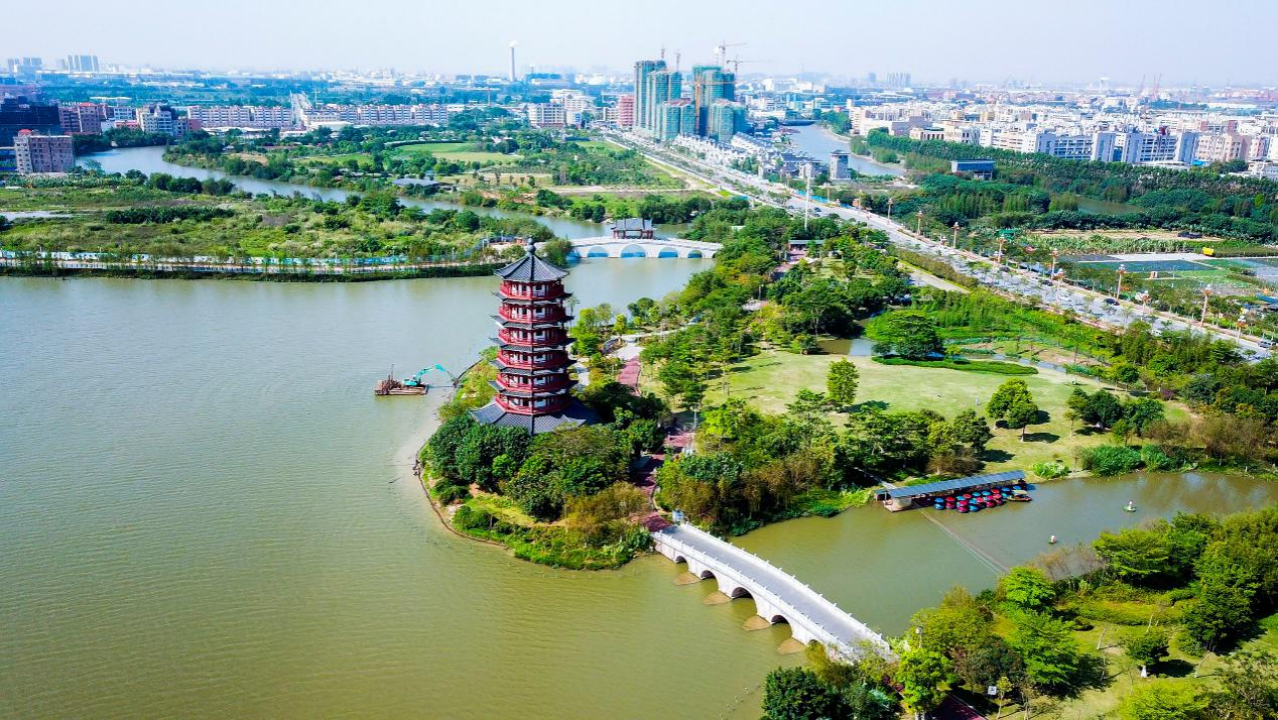
Dongguan is a garden city. It has long summers and no winter weather. It boasts abundant sunshine and rainfall, small temperature differences, and obvious monsoon. The picture below shows Huayang Lake National Wetland Park in Machong, Dongguan.
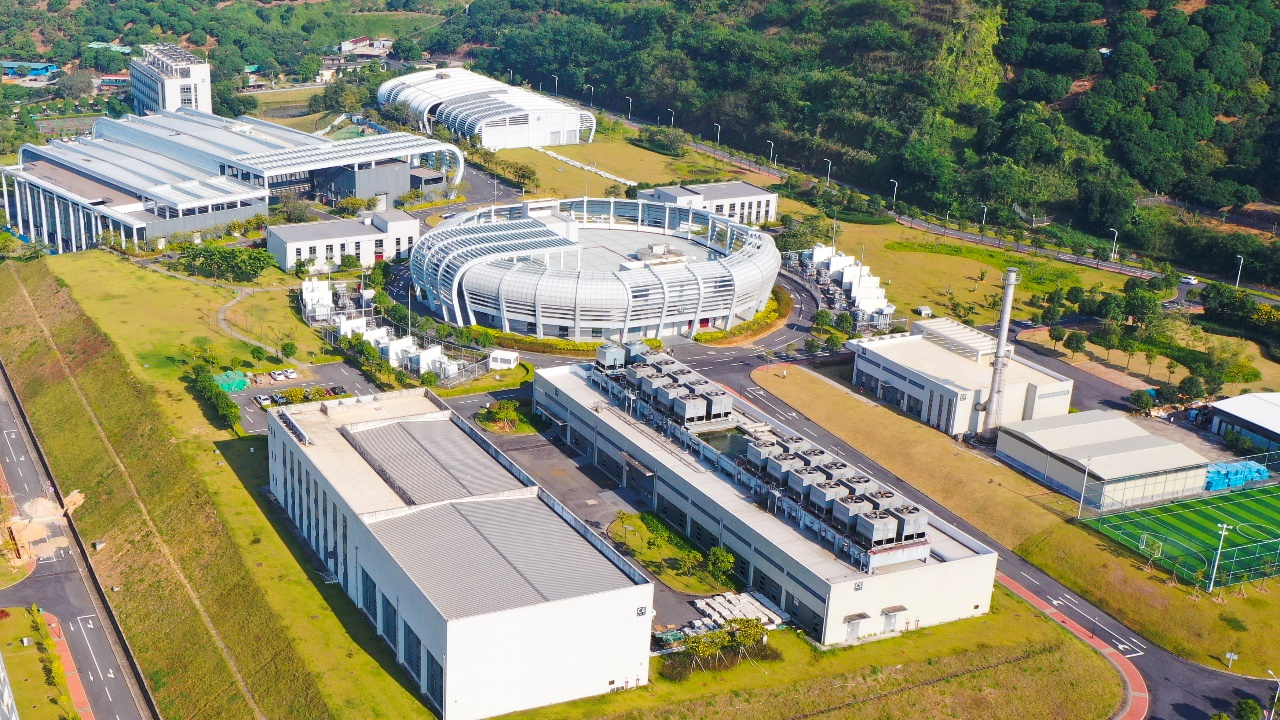
Dongguan has become a national innovation city, ranking third among the top 20 science-technology innovation cities in China. Its original innovation ability has been further enhanced, and big science devices, such as the China Spallation Neutron Source Phase II and Advanced Attosecond Lasers, have been incorporated into the 14th Five-Year Plan of national major science and technology infrastructure. The picture below shows the China Spallation Neutron Source in Dongguan.
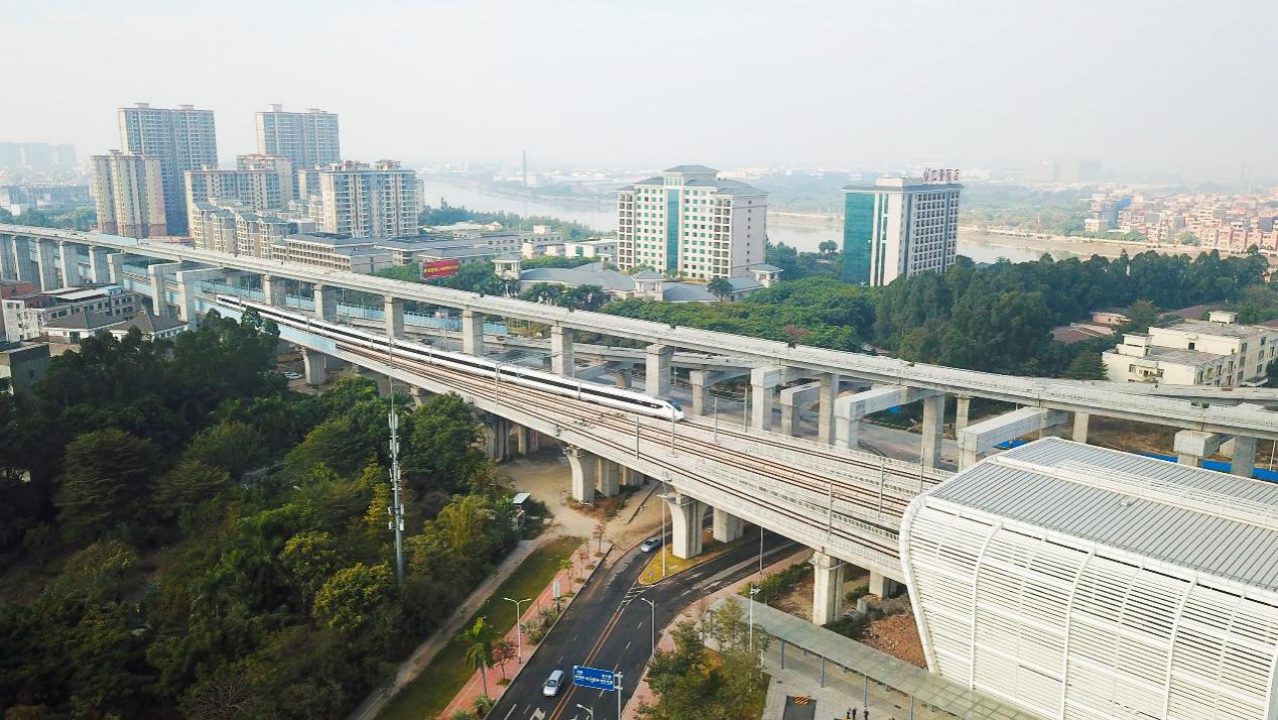
In 2021, Dongguan made a major breakthrough in participating in the construction of the Guangdong-Hong Kong-Macao Greater Bay Area. A number of major transportation facilities were interconnected. Jiangxi-Shenzhen High-speed Railway, Guangzhou-Shenzhen Intercity Railway, Dongguan-Huizhou Intercity Railway, Dongguan-Panyu Expressway Phase I and Phase II, and Shenzhen Outer Ring Expressway Dongguan Section were completed and opened to traffic. The picture below shows Dongguan West Station to the Guangzhou-Shenzhen Intercity Railway.
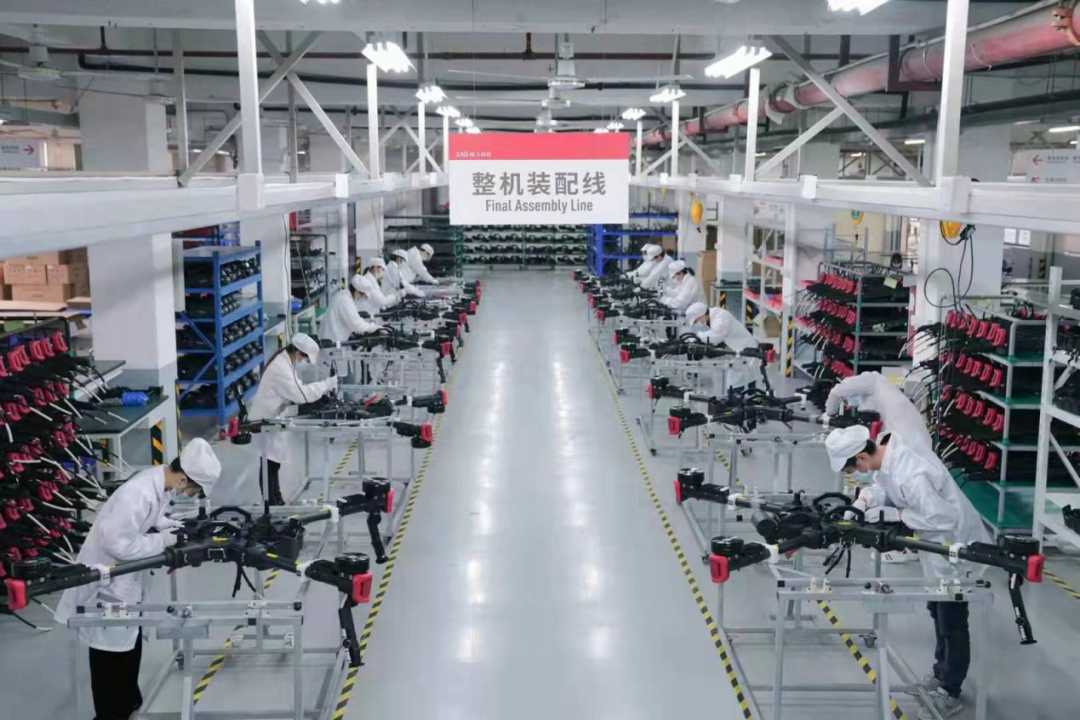
In 2020, Dongguan utilized the construction of seven strategic emerging industrial bases as a breakthrough, and it endeavored to cultivate new development momentum. Emerging industries such as integrated circuits and key components, smart device manufacturing, strategic frontier materials, and bio-pharmaceuticals increased by 19.7%, 21.1%, 44%, and 34.4%, respectively. This showed accelerated growth with emerging industries. The picture below shows the final assembly line of a manufacturing business in Dongguan.
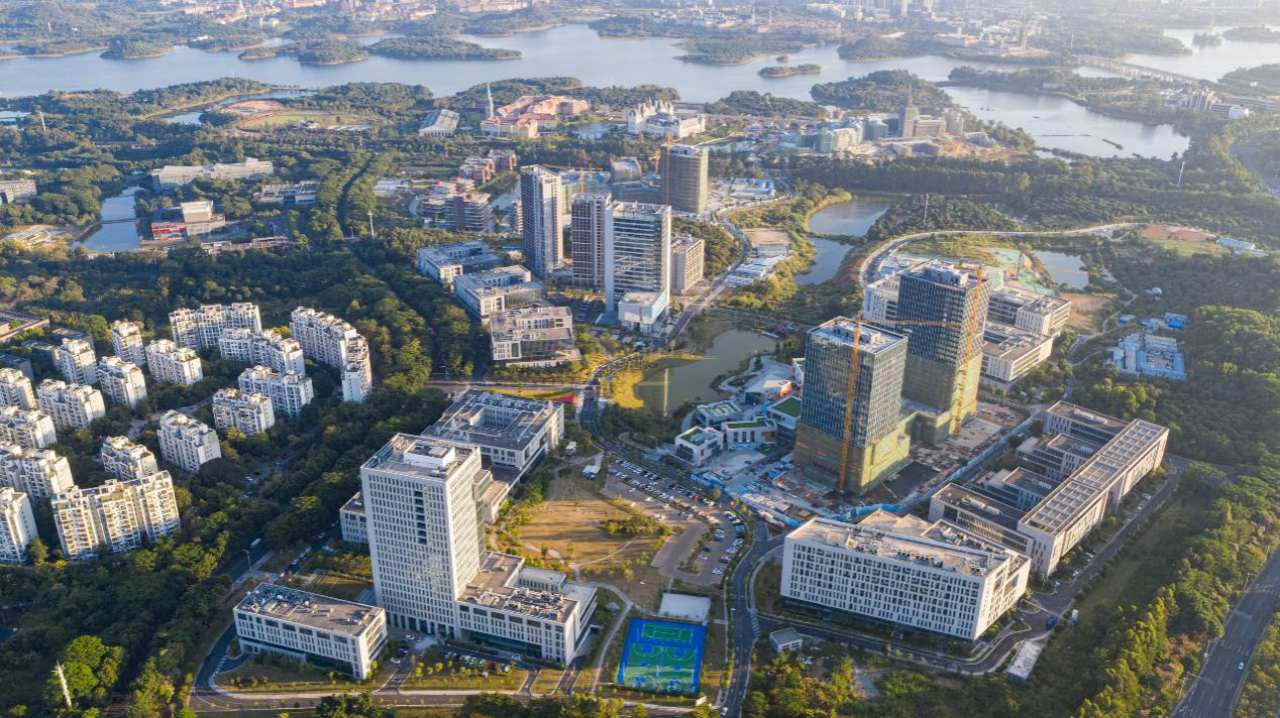
In 2021, the GDP of Dongguan reached 1,085.535 billion RMB, an increase from the prior year of 8.2%. The added value of industrial businesses above the designated size in Dongguan increased by 10.2% from the previous year. The picture below shows the Songshan Lake International Innovation Entrepreneurship Community.
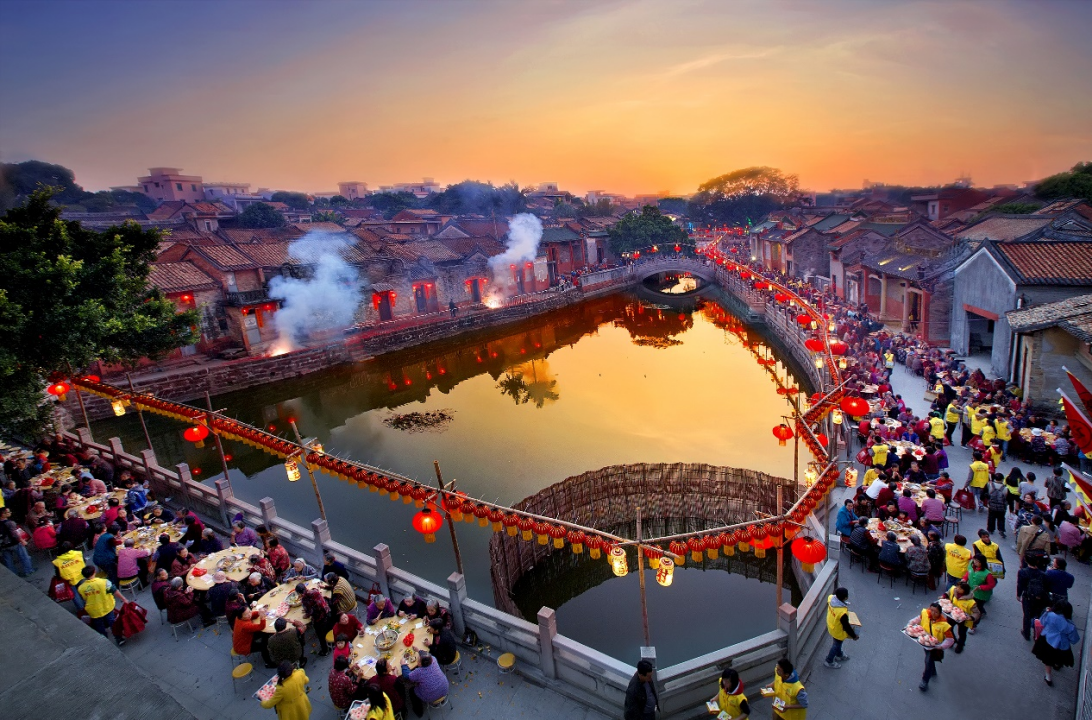
Dongguan is a famous, historical, and cultural city in Guangdong Province. It is home to historical and cultural heritage, such as Lin Zexu Opium Disposal Tank, Shajiao Fort, and other sites of anti-British ancient battlefields, Keyuan Garden, the former residence of Yuan Chonghuan, etc. The picture below shows a colorful cultural event in Nanshe ancient village.
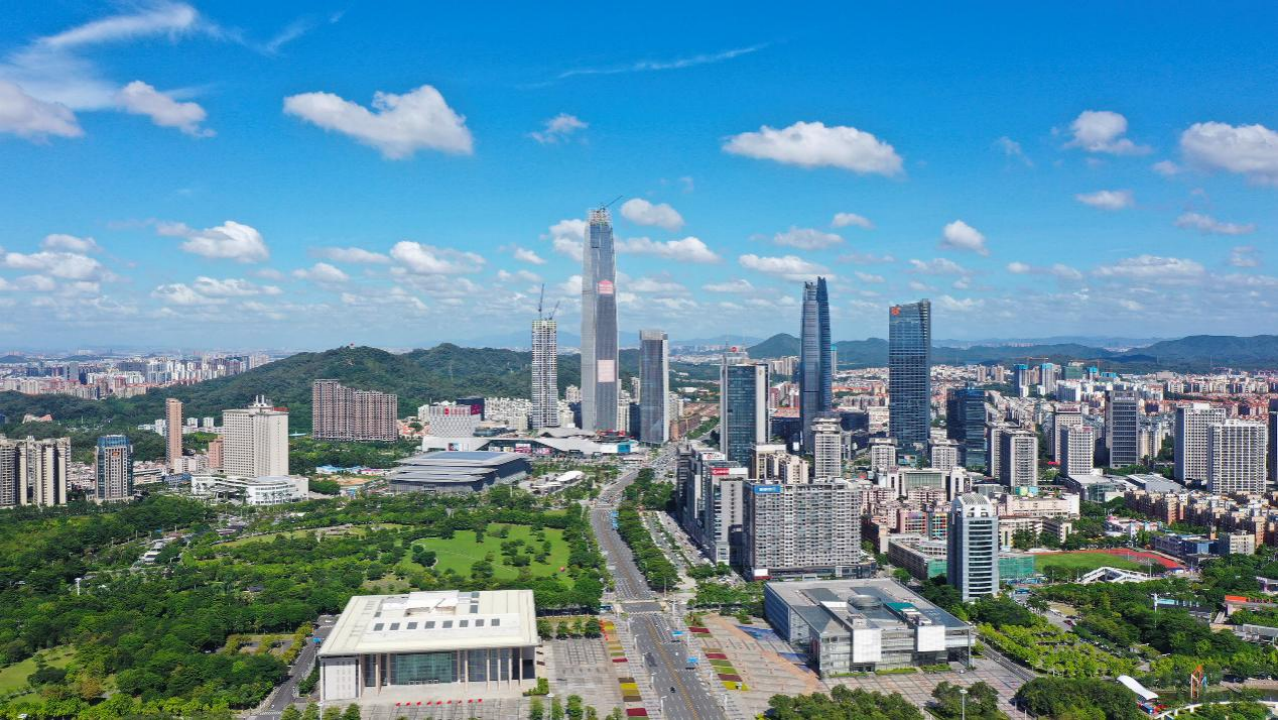
Dongguan is located in the south-central part of Guangdong Province. It rests on the east bank of the Pearl River Estuary and in the Pearl River Delta at the lower reaches of the Dongjiang River. It received its name by being located in the east (Dong) of Guangzhou and because of its richness in Scirpus (Guan). The picture below shows the skyline of Dongguan.
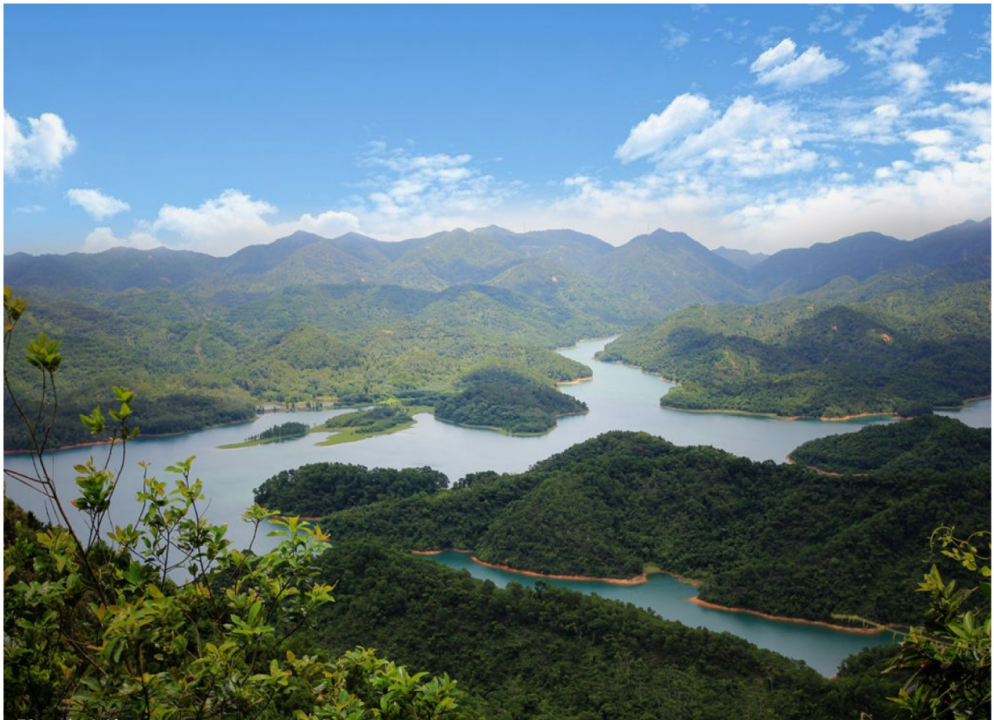
In terms of ecological environment, Zhongshan City has designated 164 square kilometers of land ecological conservation redline and 65.3 square kilometers of marine ecological conservation red line. It has built 36 forests and wetland theme parks, as well as 20 natural reserves, covering a total area of 11,011 hectares. The picture below shows the Zhongshan Yangtze River Reservoir.
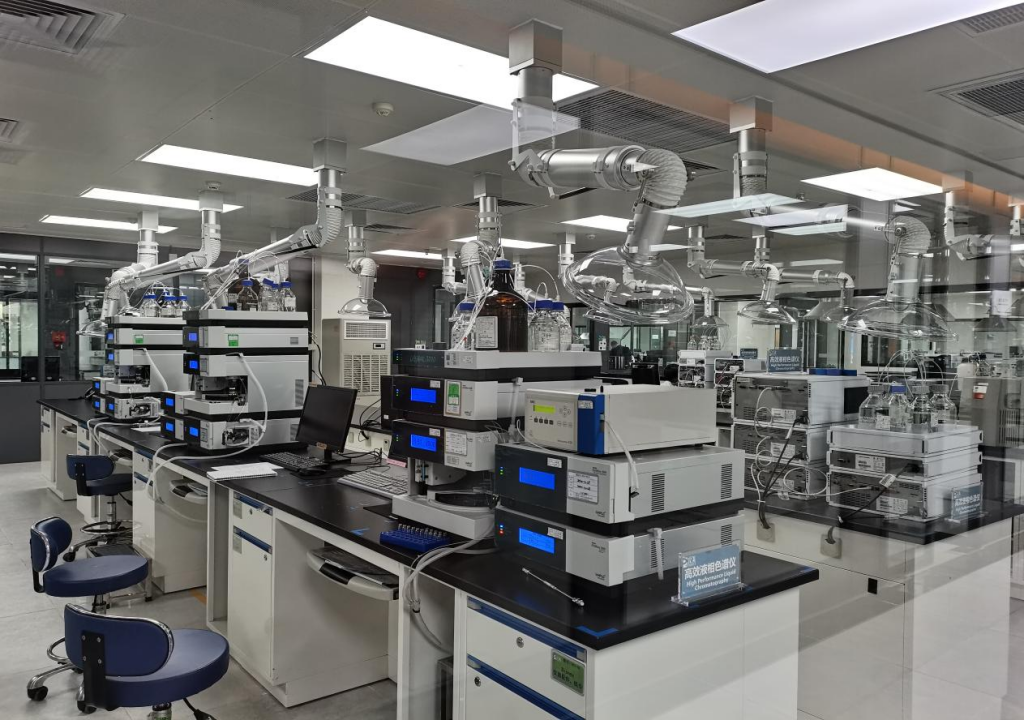
In terms of scientific and technological innovation, the city has introduced 15 high-end innovation platforms from universities and research institutes, established 9 provincial-level R&D institutions, and is home to 484 various innovation platforms, at and above the provincial level. The picture below shows a laboratory work area in Zhongshan.
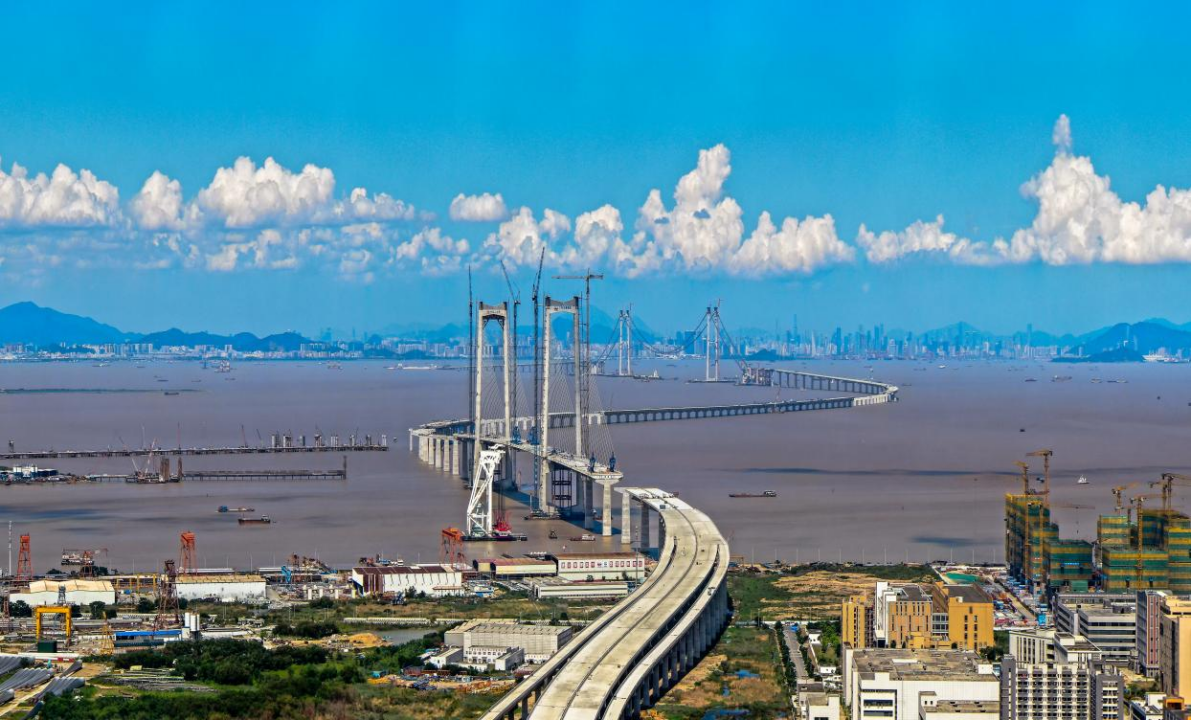
Zhongshan has solidly promoted traffic construction, with a total highway mileage of 3,307.4 kilometers. The construction of a number of major traffic projects, such as Nansha Port Railway and Shenzhen-Zhongshan Link, is being accelerated. The picture below shows the Shenzhen-Zhongshan Link under construction.

In recent years, the economic operations in Zhongshan have stabilized and rebounded. The number of market players has increased by 187,000, and the total number has exceeded 510,000. The added value of advanced manufacturers accounts for 48.4% of that of industrial companies above the designated size. The investment structure has improved significantly, with industrial investment and infrastructure investment increasing to 22.4% and 32.7%, respectively. The picture below shows the workshop of a business in Zhongshan.
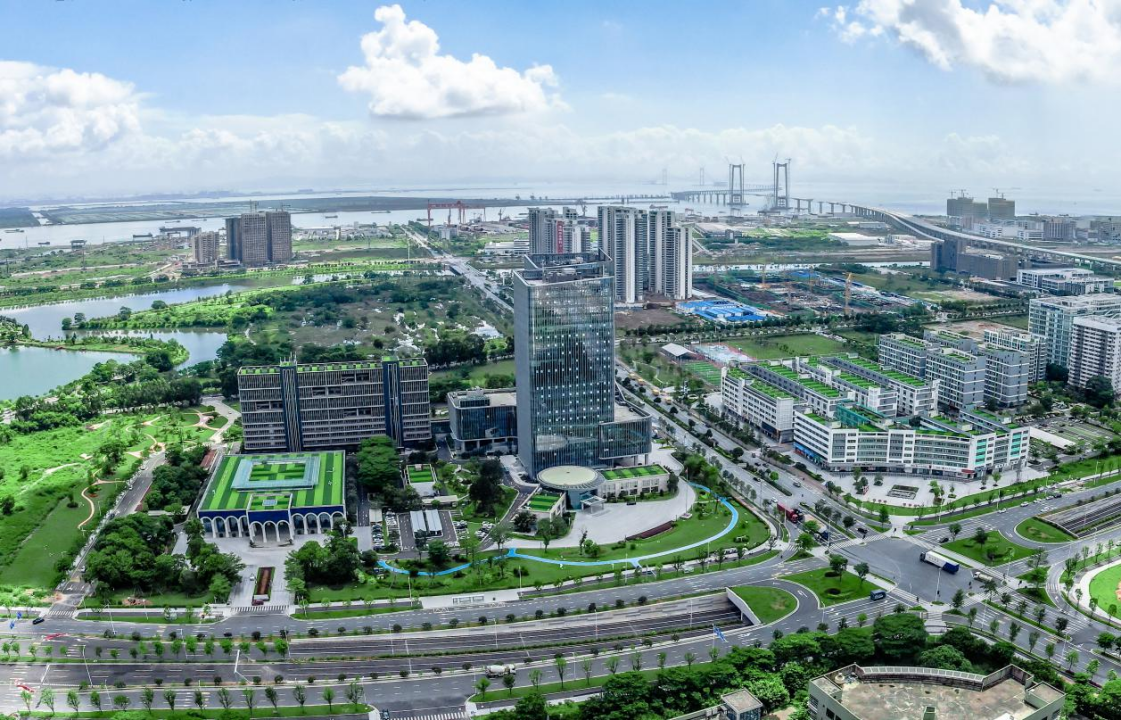
Zhongshan City comprises 15 towns and 8 subdistricts under its jurisdiction. The area contains a national development zone - the Zhongshan Torch High-tech Industrial Development Zone, and an economic cooperation zone - Cuiheng New District. The picture below shows Cuiheng New District under construction.
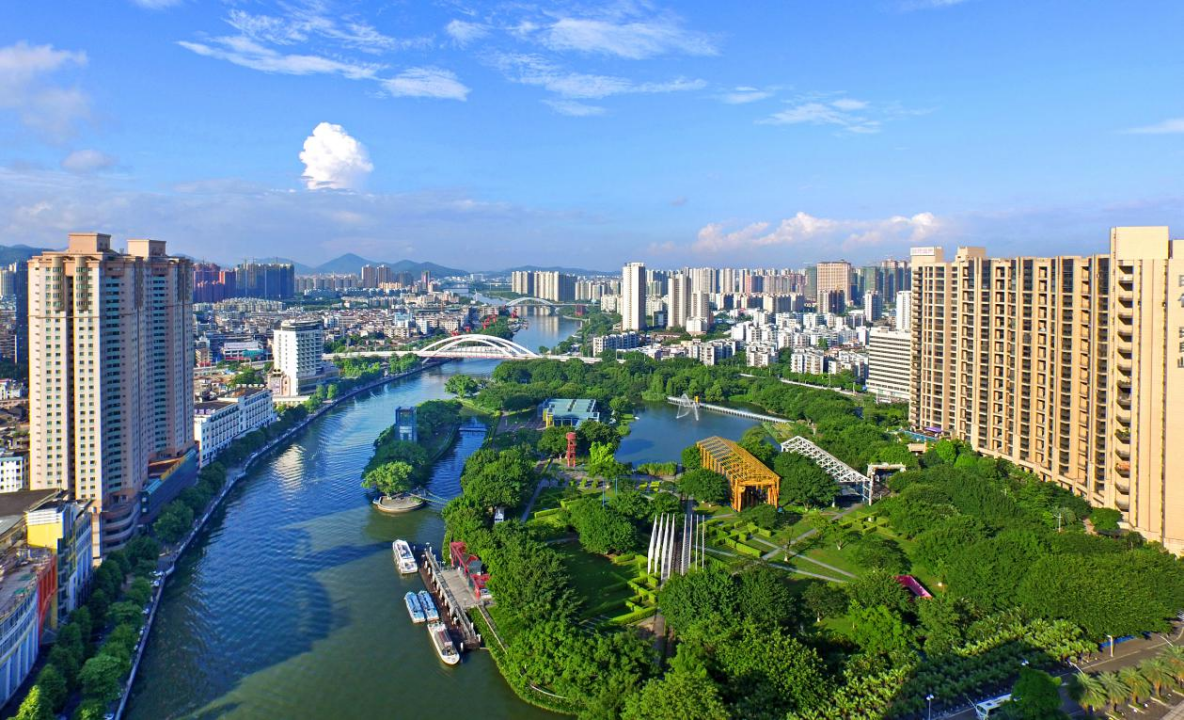
Zhongshan is adjacent to Hong Kong and Macao; it is located at the sea gate at the lower reaches of the West and North Rivers in the south-central portion of the Pearl River Delta. It covers a total area of about 1,784 square kilometers. The picture below shows the skyline of Zhongshan.
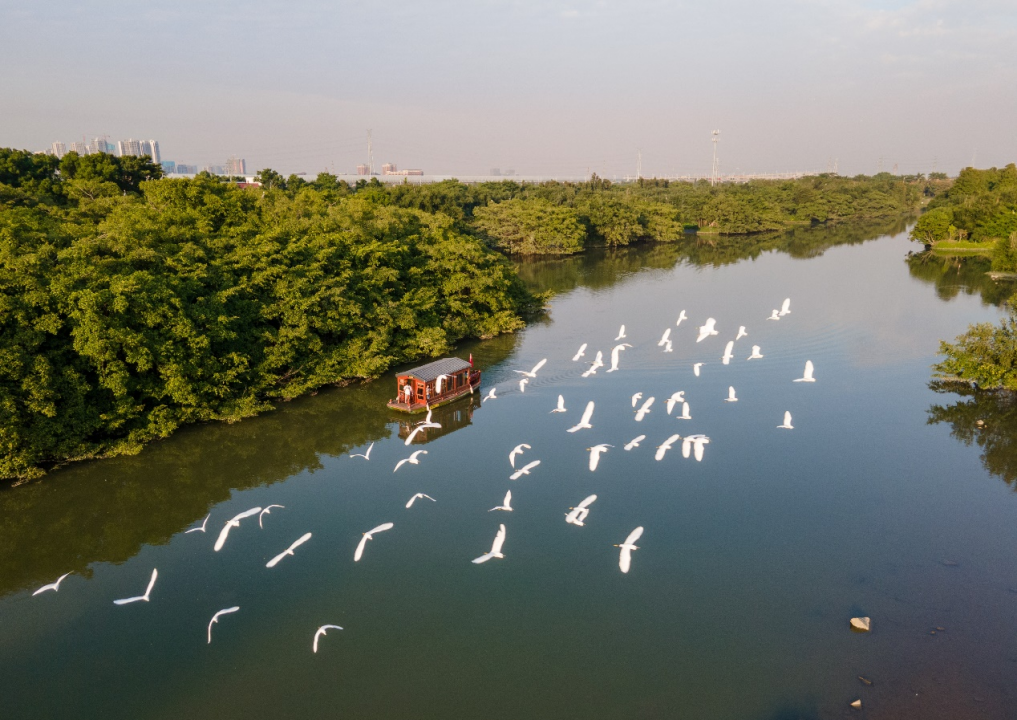
Jiangmen has obvious advantages in the integrated resources of sea area, coastline, islands, harbors, beaches, tourism, and fisheries. Rich natural resources and a favorable natural environment have attracted a variety of small animal species to settle here. The picture below shows the Birds' Paradise in Jiangmen; a flock of egrets are hovering in the air.
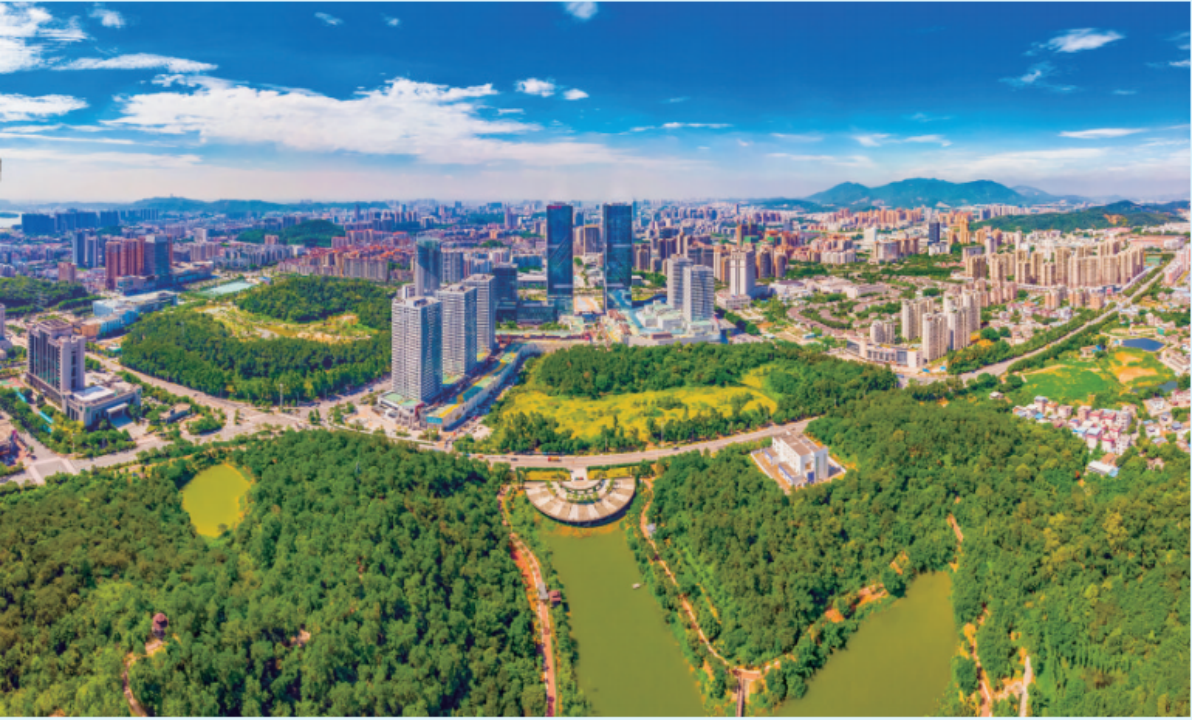
The construction of the Daguanghai Bay Economic Zone has been accelerated, the construction of Yinhu Bay Coastal New Area has steadily advanced, and the No. 1 and No. 2 machine sets of Taishan Nuclear Power have been placed into commercial operation. The green advantages of ecological development zones have been gradually released. The building of an all-for-one tourism demonstration city has been solidly promoted. The picture below shows Jiangmen with its numerous green areas.
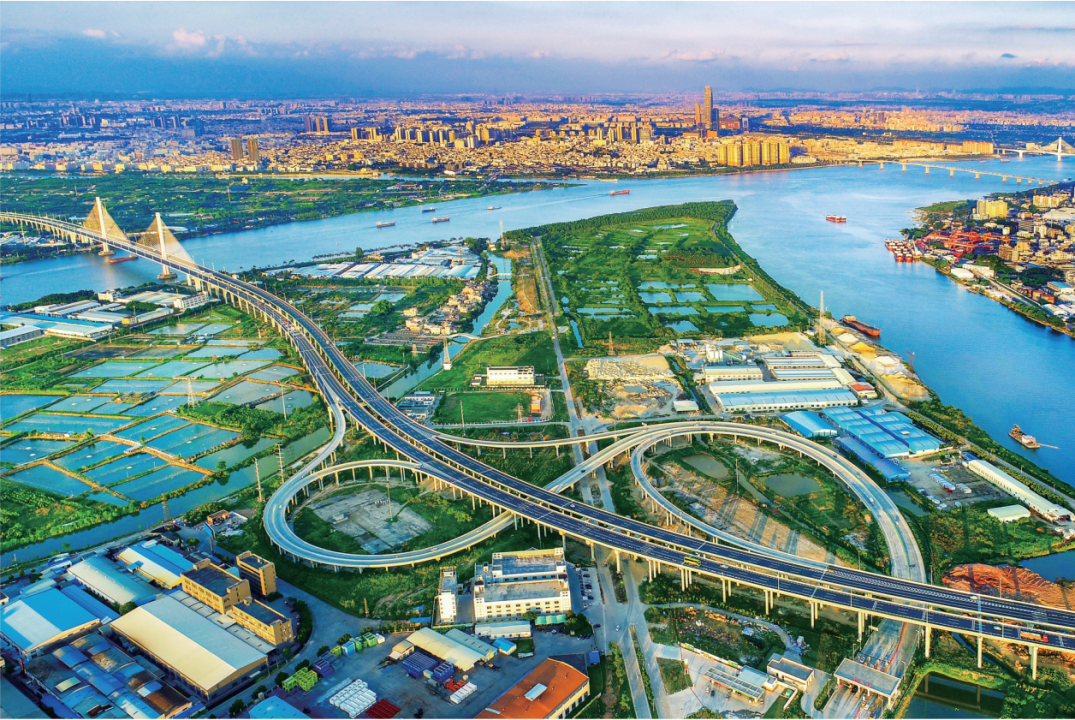
Jiangmen has steadily promoted the planning and construction of Jiangmen Talent Island. As of 2021, the infrastructure of Jiangmen Talent Island had basically taken shape, successfully attracting a number of high-quality projects, key projects, and science-technology industrial parks, such as Guangdong Academy of Sciences, Tencent, Huawei, IBM, and China Electronics Corporation to settle in this science and technology industrial park. The picture below shows Jiangmen Talent Island under construction.
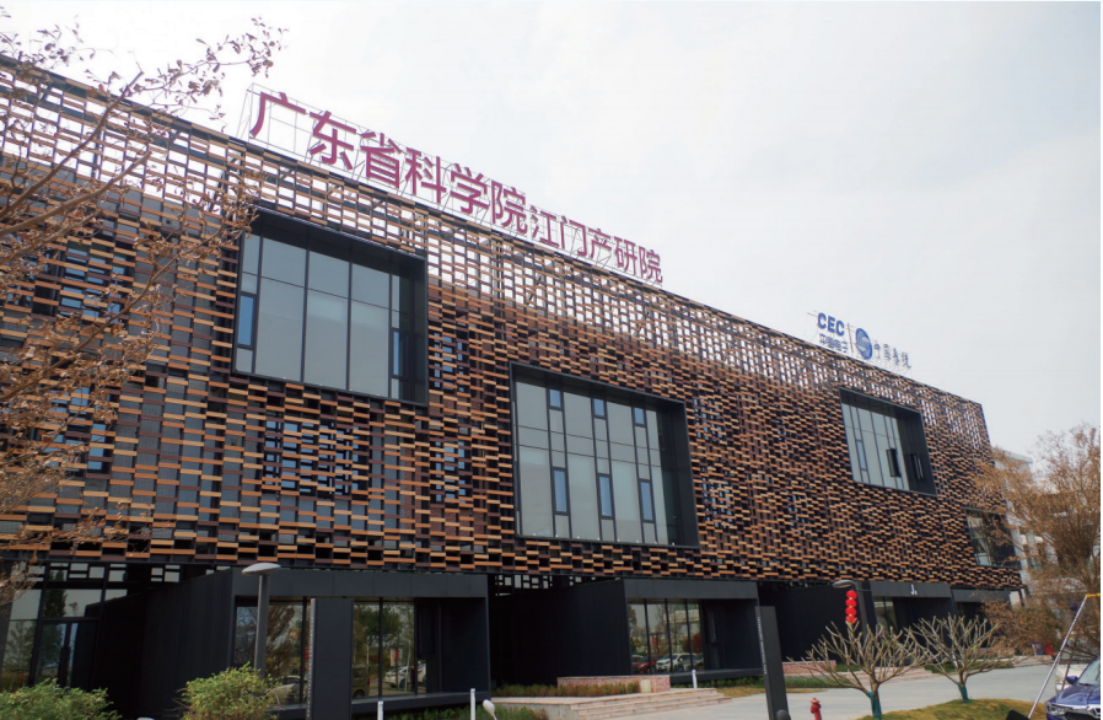
The scientific and technological innovation capability of Jiangmen has been continuously improved. There are more than 1,800 national high-tech companies, with a total industrial output exceeding 500 billion RMB and the output of five emerging industries exceeding 210 billion RMB. The picture below shows GDAS Jiangmen Industrial Technology Research Institute.
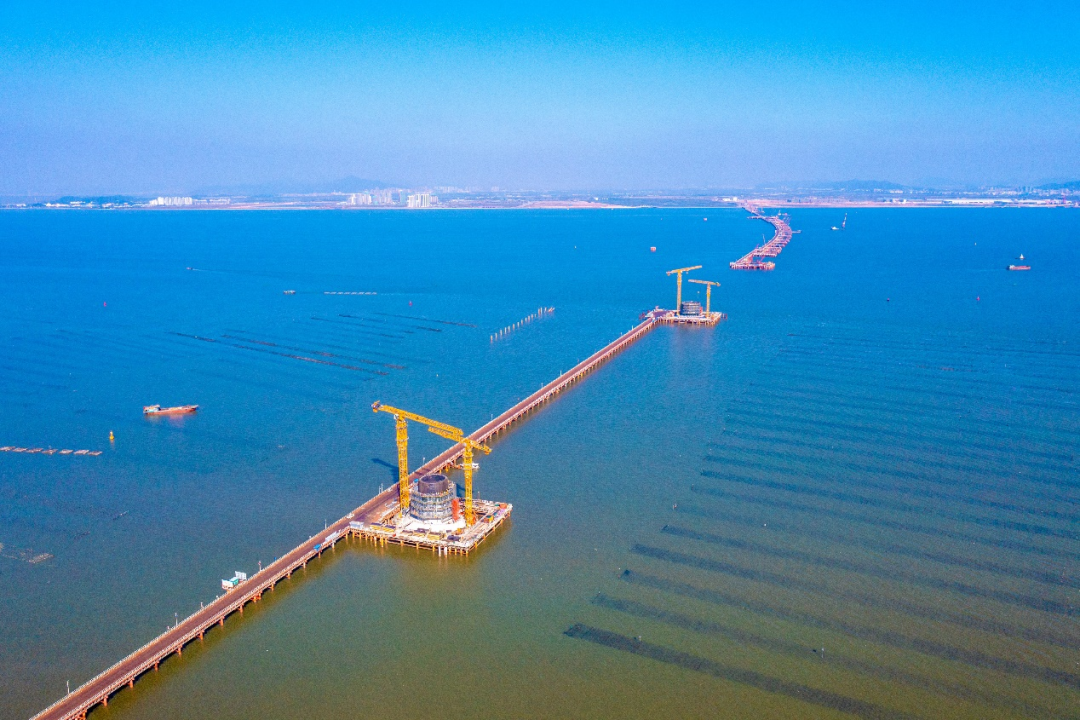
After the completion of the Huangmao Sea Cross-sea Passage, the Hong Kong-Zhuhai-Jiangmen-Western Guangdong Passage will be formed, which will play a key supporting role in strengthening the development of the Jiangmen Daguanghai Bay Economic Zone. The picture below shows the Huangmao Sea Bridge under construction.
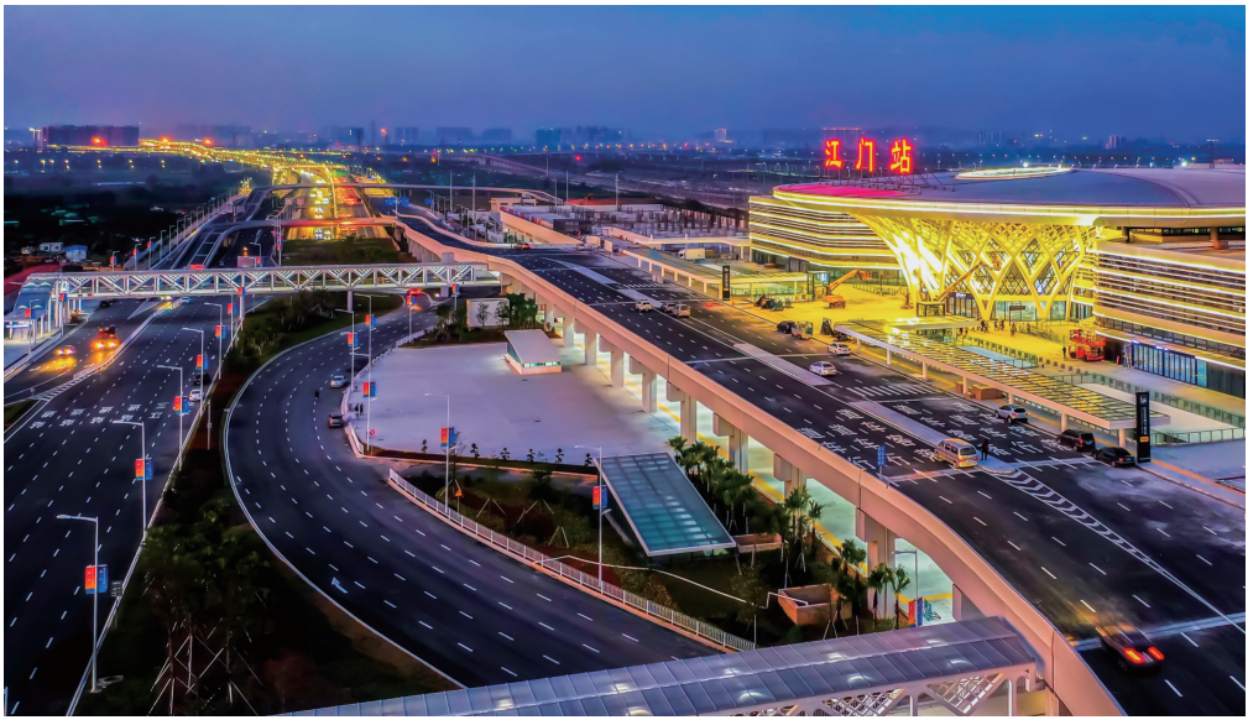
Jiangmen is making every effort to build an interconnected modern comprehensive transportation system. Jiangmen Station, with a total construction area of 254,500 square meters, has been put into operation. With 13 criss-cross high-speed railway lines and inter-city railways extending in all directions, a three-dimensional and diverse transportation network has made travel more convenient. The picture below shows Jiangmen Station.
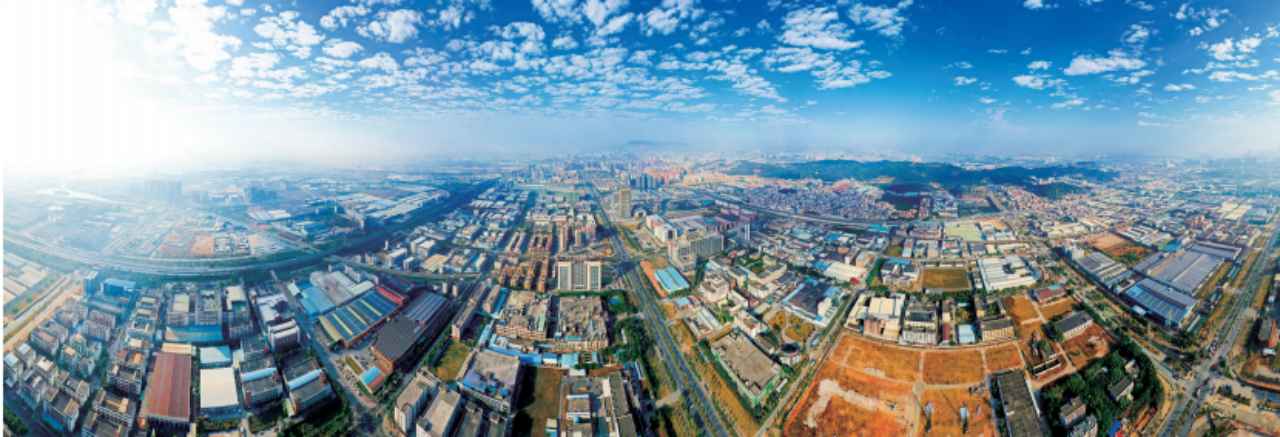
In 2021, the GDP of Jiangmen was RMB 360.128 billion, an increase from the previous year of 8.4%. Notably, its per capita GDP increased by 7.5%. The picture below shows the Jiangmen National High-tech Zone.
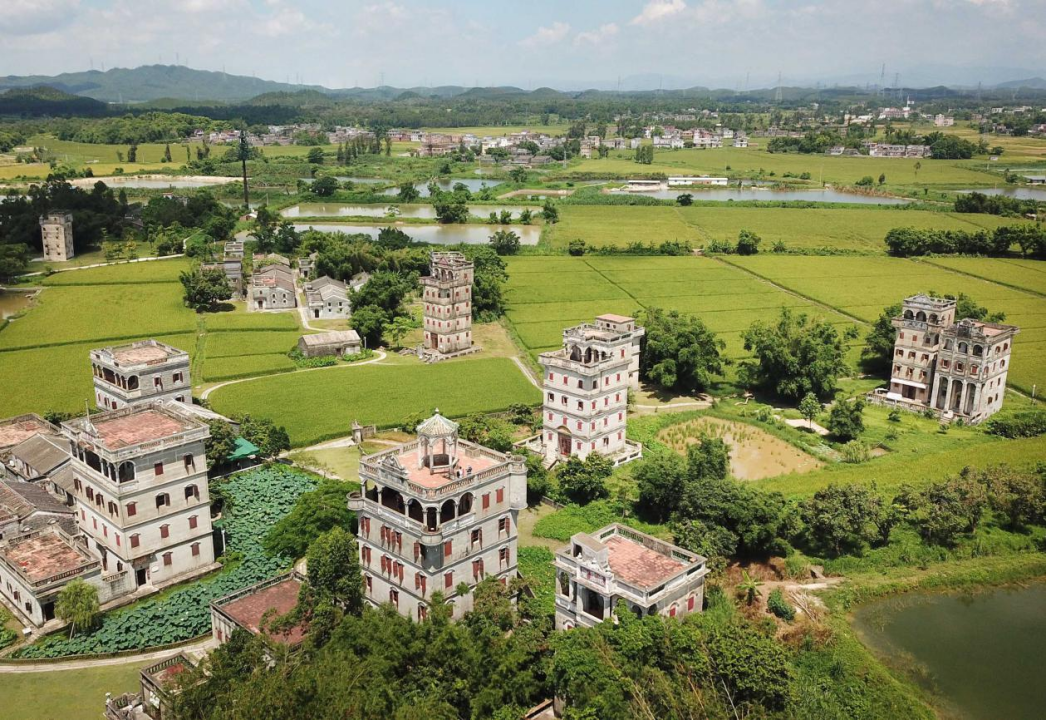
Jiangmen boasts a long history and profound cultural heritage; it is known as the hometown of overseas Chinese. The footprints of more than 4.5 million overseas Chinese have spread all over the world. It is also home to Kaiping Diaolou and Villages, a world cultural heritage site. The picture below shows Kaiping Diaolou in Jiangmen.
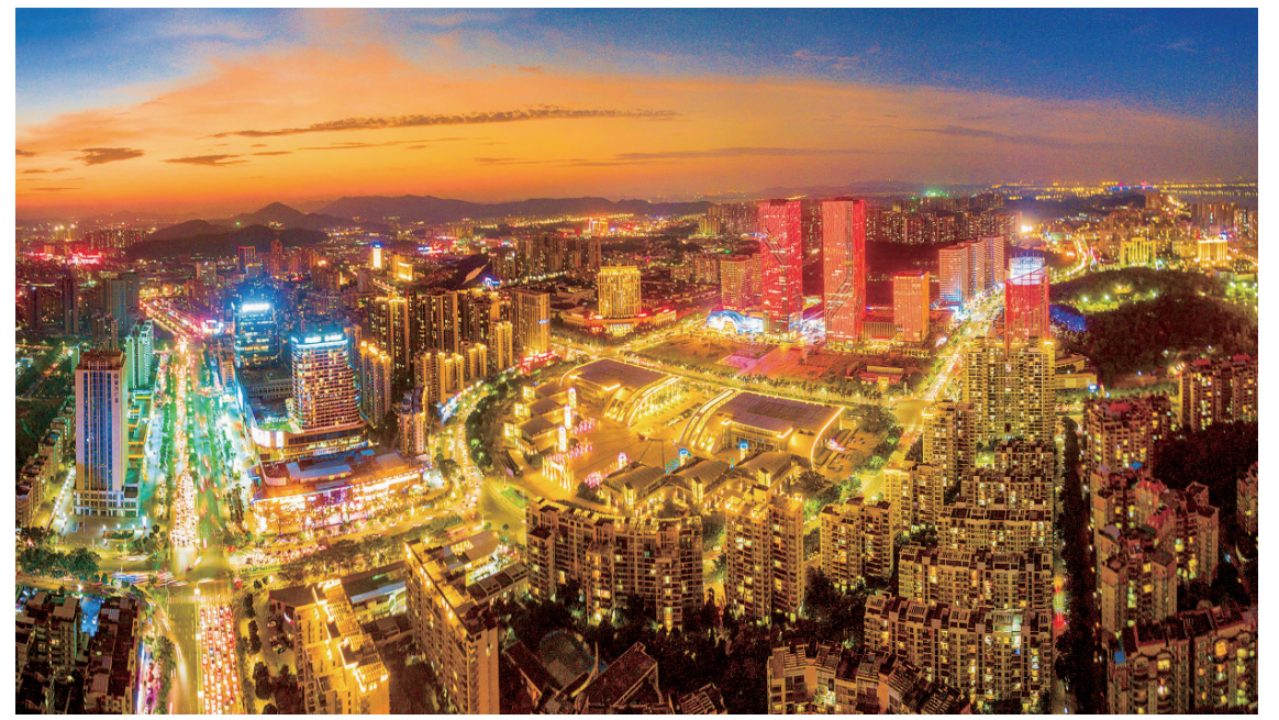
Jiangmen is located in the south-central part of Guangdong Province and the west wing of the Pearl River Delta. It is a key node city in the Guangdong-Hong Kong-Macao Greater Bay Area. Jiangmen covers an area of 9,535 square kilometers and a sea area of 2,886 square kilometers. The picture below shows the bustling Jiangmen business district.
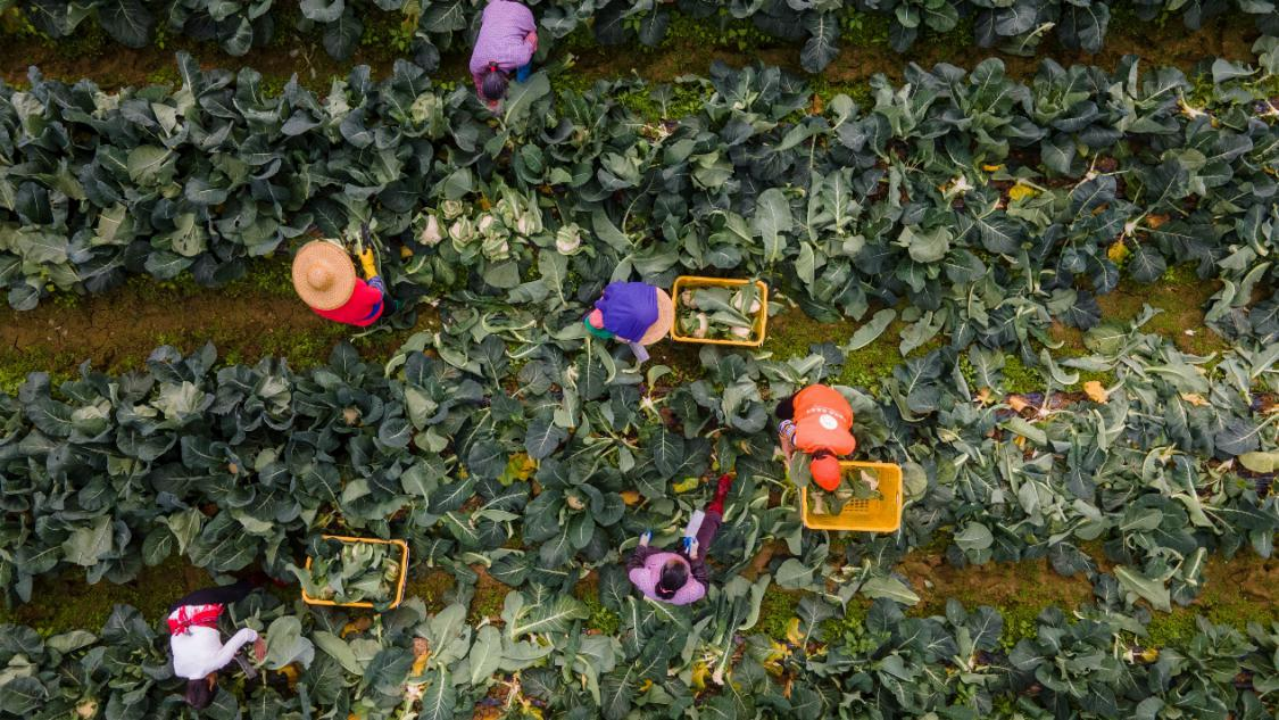
In 2021, the per capita disposable income of all residents in Zhaoqing increased by over 10%. The air and water environment of Zhaoqing ranks among the top in China, and the citizens of Zhaoqing have gained a healthier lifestyle. The picture below shows a work team from Huangtian Town helping villagers to collect vegetables on the eve of the Spring Festival.
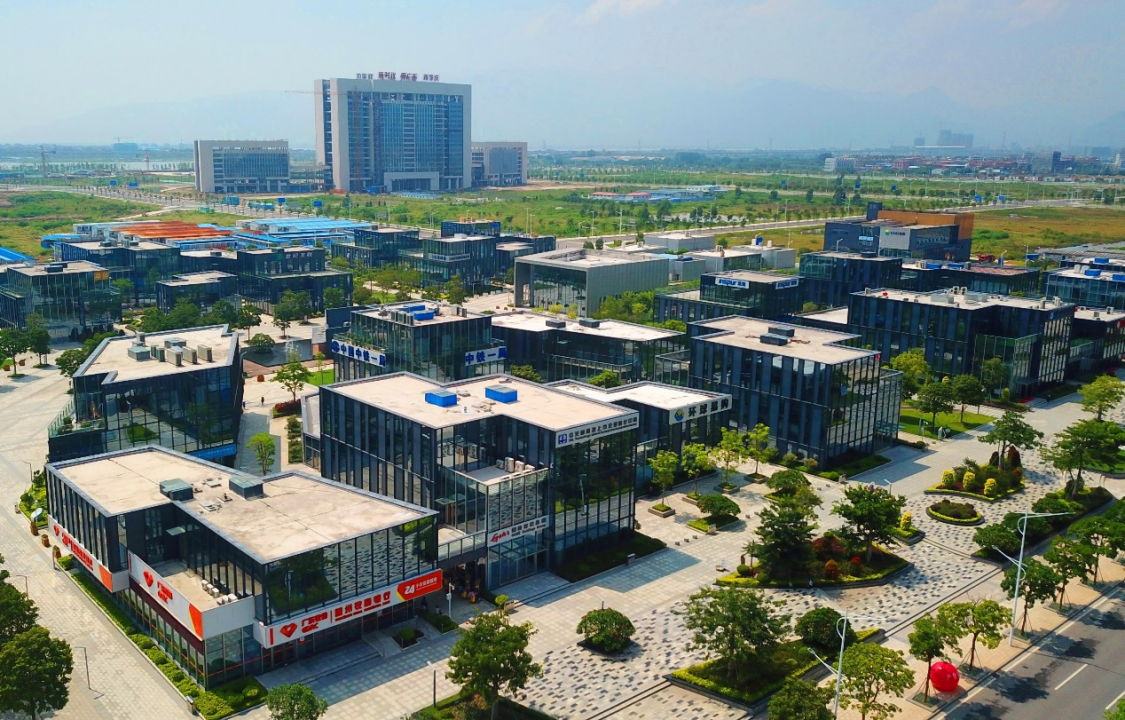
Zhaoqing New District was supported by the province to build a Guangdong-Hong Kong-Macao characteristic cooperation platform, and Zhaoqing High-tech Zone has become a national intellectual property demonstration park. It has been included in the national demonstration zone for the transfer and transformation of scientific and technological achievements in the Pearl River Delta. The picture below shows the Science-technology Innovation Center of Zhaoqing New District.
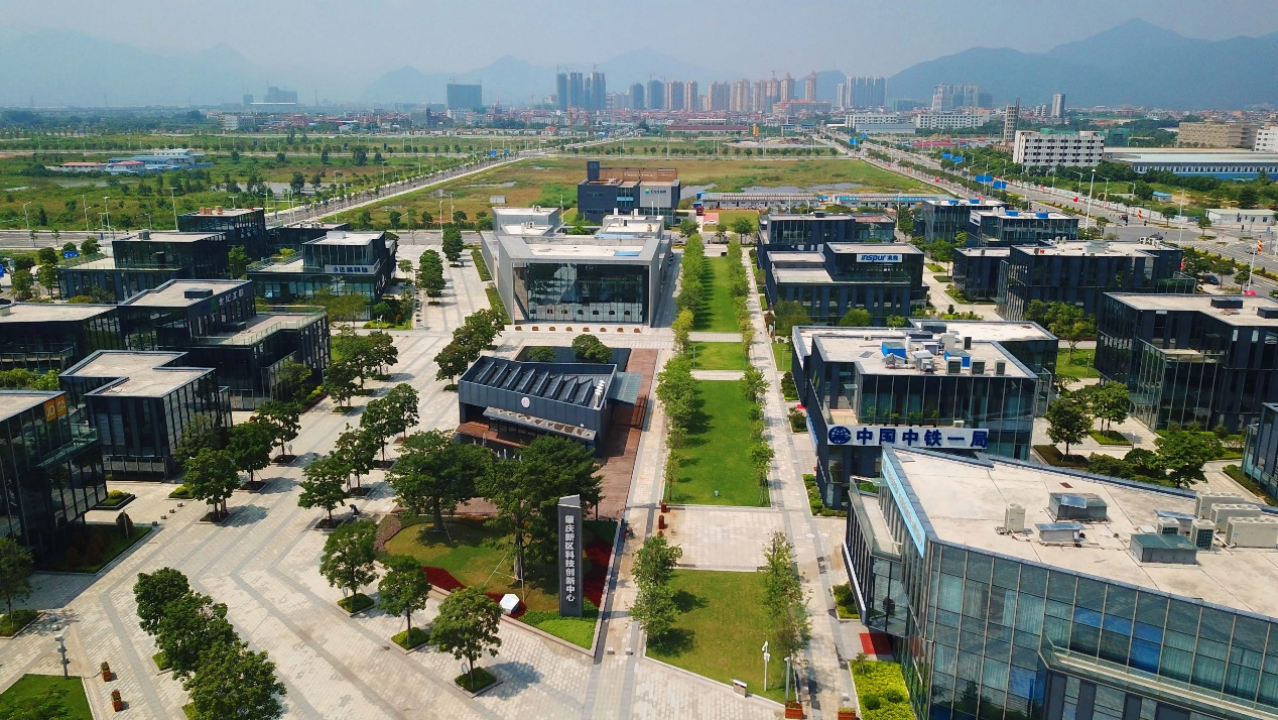
Thanks to the development of industrial economy, Zhaoqing has achieved sizeable economic growth. In 2021, the regional GDP of Zhaoqing exceeded 260 billion RMB, an increase of more than 10% from the previous year. The picture below shows the Science-technology Innovation Center of Zhaoqing New District.
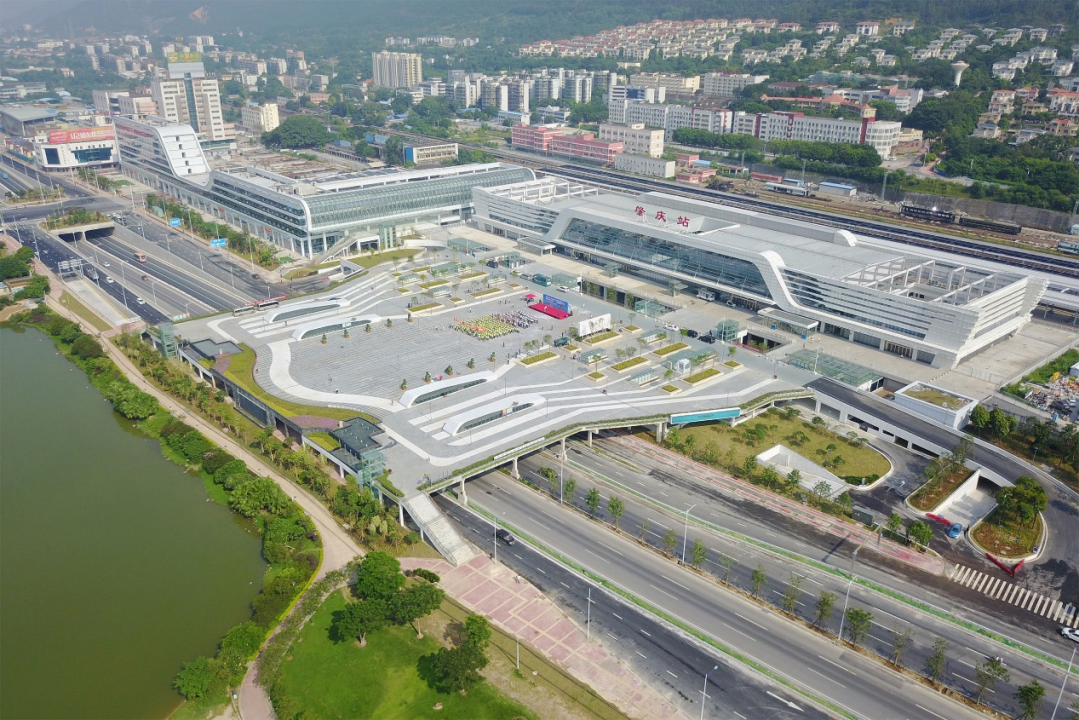
In recent years, the infrastructure construction of Zhaoqing has been accelerated in all aspects. The city has invested 49.8 billion RMB in transportation infrastructure, making it one of the most uncongested cities in Guangdong for three consecutive years. The picture below shows the beautiful Zhaoqing Railway Station Complex.
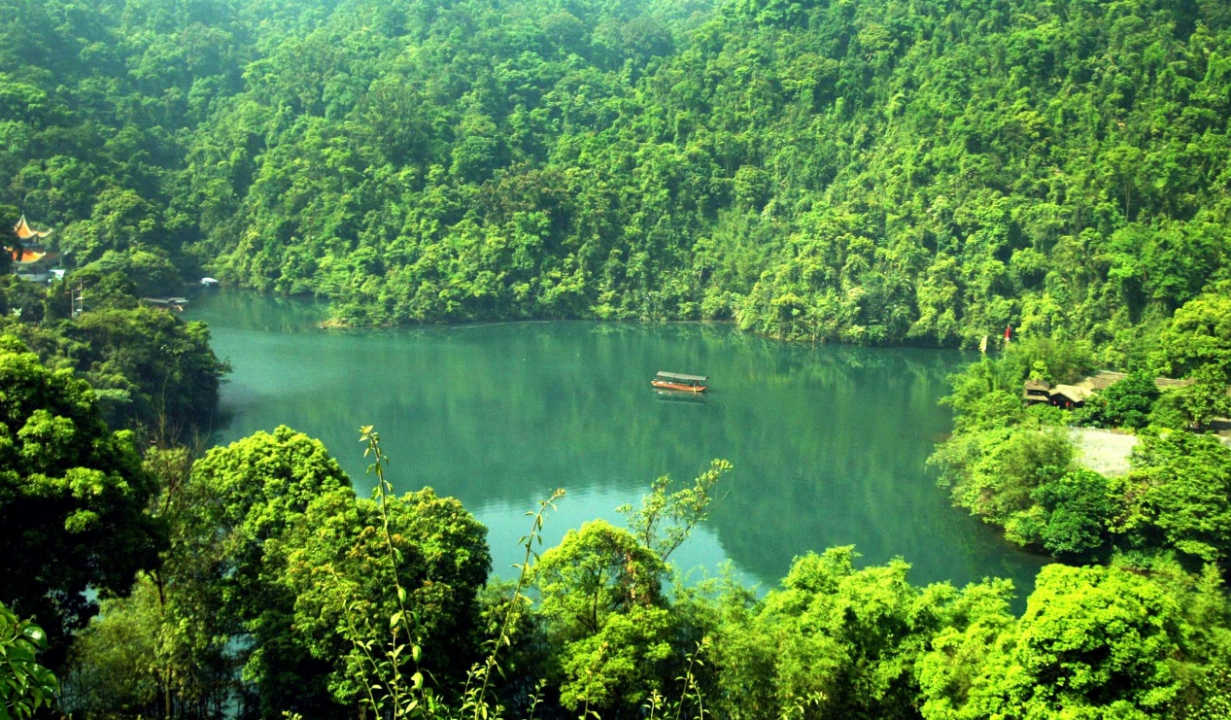
When you arrive in Zhaoqing, you will encounter a vast expanse of green hills and clear waters seemingly by chance. You are instantly embraced by the natural majesty of trees, flowers, lakes, and hills. The city is so close to nature that you soon forget your troubles and relax in the tranquility of the outdoors. The picture below shows Dinghu Mountain scenery.
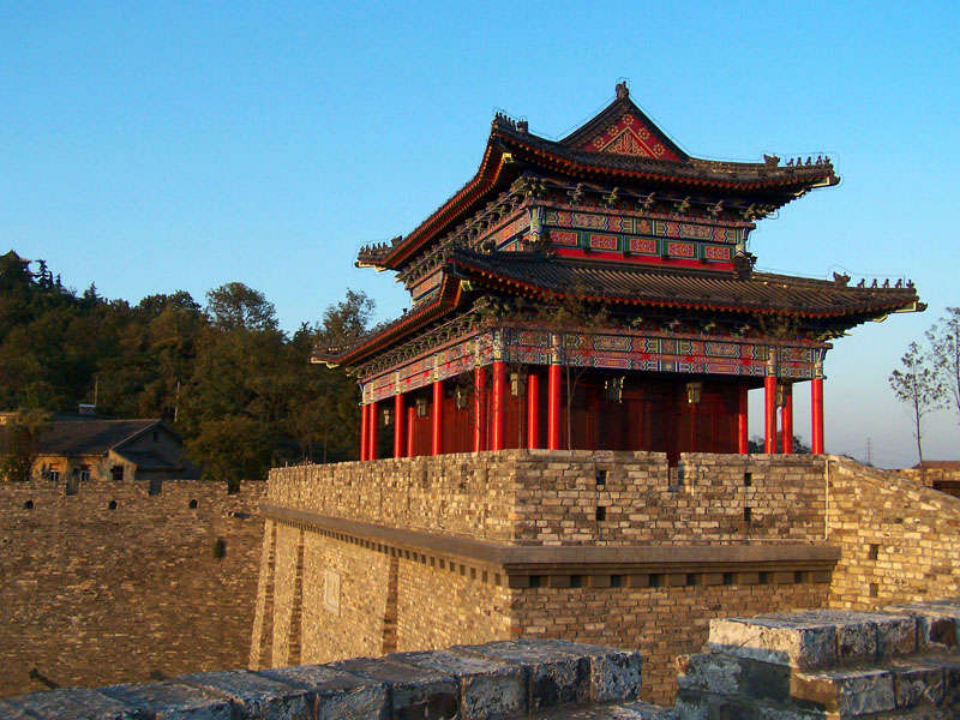
has a history of more than 2,200 years. It won the titles of National Historical and Cultural City, China Excellent Tourist City, National Civilized City, National Hygienic City, and National Forest City. The picture below shows Piyun Tower in Zhaoqing.
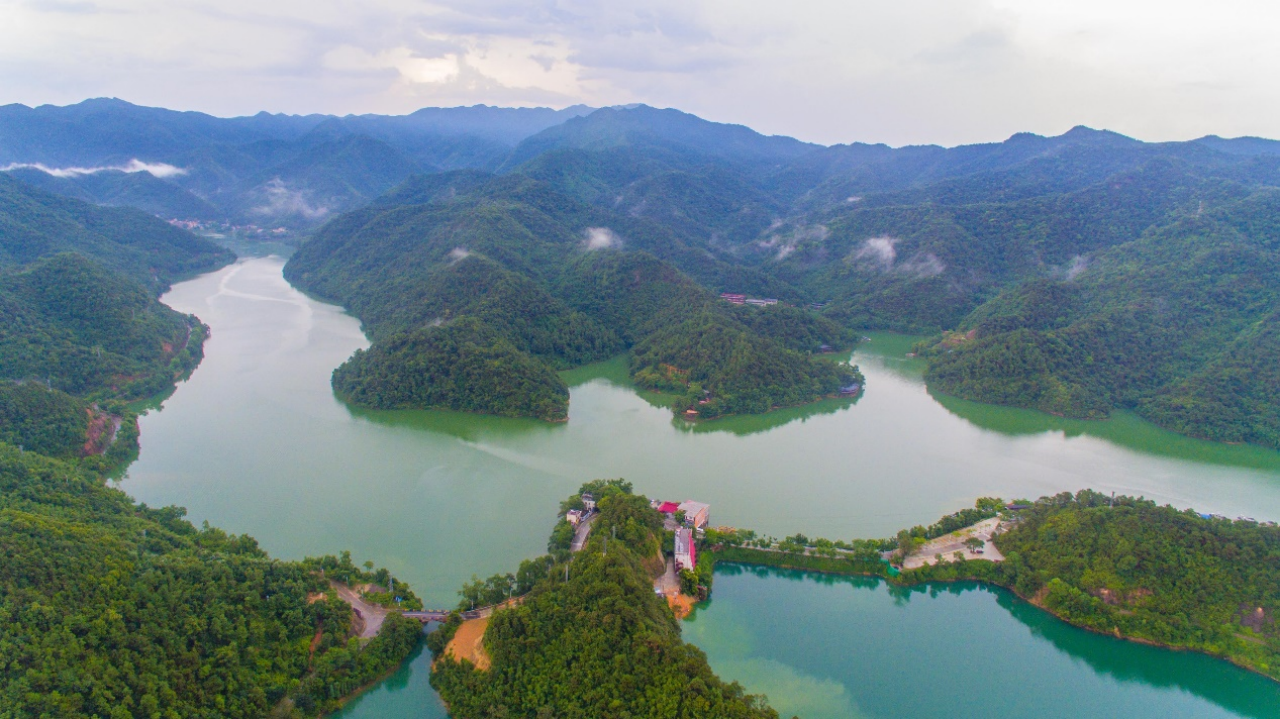
Zhaoqing is located in the west-central part of Guangdong Province and the middle reaches of the Xijiang River. It is a key node city in the Guangdong-Hong Kong-Macao Greater Bay Area. Zhaoqing has a long history and profound cultural heritage. The picture below shows Jiulong Lake in Zhaoqing.
主办单位:广东省推进粤港澳大湾区建设领导小组办公室
承办单位:南方新闻网
Copyright © 2019 www.cnbayarea.org.cn All Rights Reserved.
ICP备案号:粤B2-20050252
提示:为达到最佳体验效果,建议使用IE10或以上版本的浏览器访问本网站。

Scan and Share

Scan and Follow the Official Account
